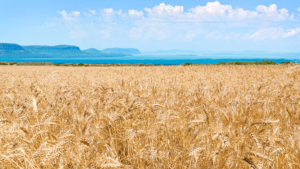Field observations
Summer 2023
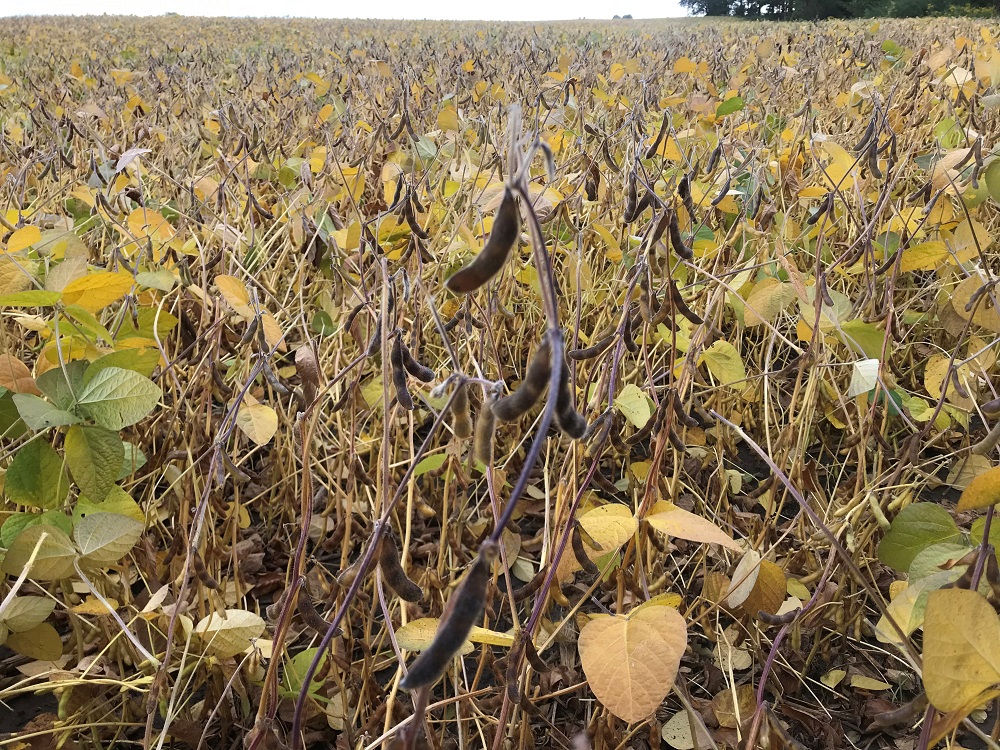
September 21, 2023
This week, there is some good and bad news. The good is that soybean harvest has begun or is not that far around the corner (be sure that combines, planters, and winter wheat seed are ready to roll). The bad news is that Gibberella ear rot is showing up in corn.
Corn
Corn is creeping towards physiological maturity. While that is happening, disease pressure is ramping up. Tar spot and Gibberella ear rot are two key diseases to watch for. Both diseases have been highlighted in recent weekly updates. With the incidence of Gibberella starting to show up, especially in later day hybrids, later planted fields, stress areas delaying pollination, and higher humidity areas (close to lakes, treed areas) are showing plants with tighter husks, and with continued cooler wet weather as the crop matures, Giberella fungus continues to grow in an ideal environment. The disease infection primarily occurs between two to six days after silk emergence. It will be key to monitor for this disease as this ear mould produces DON (deoxynivalenol) mycotoxin until the grain falls below 18 percent moisture. Some farmers sprayed fungicides to help lower the incidence of infection, but at this point, until harvest, there is little management that can be done. When harvest does get closer, aim to harvest infected fields early and dry the grain below 18 per cent quickly. Set the combine to blow out the lightweight infected kernels. Be prepared to store infected grain separately and test for the level of toxin to market the grain in the proper grain channel.
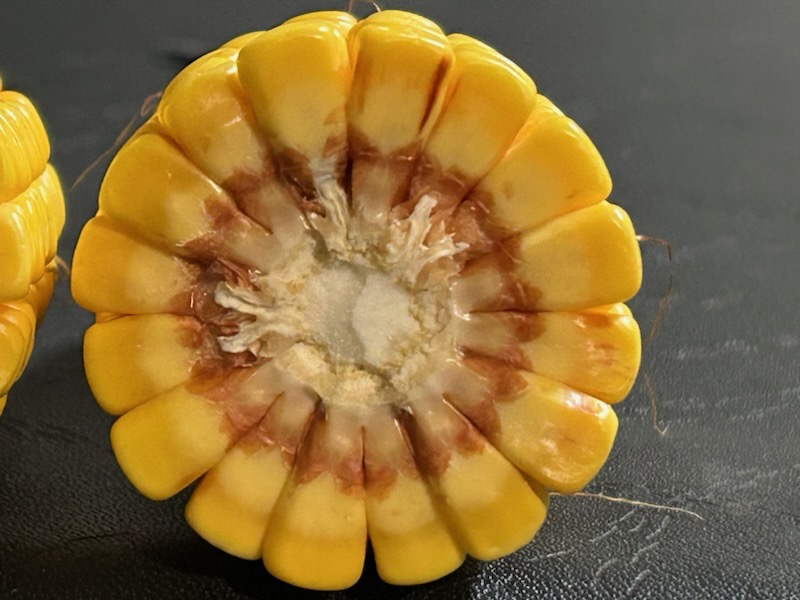
Cool temperatures overall have really slowed down corn progress (some areas hovering in the mid-single digits overnight). As of right now, there have been no reports of hard frosts. However, a killing frost before true black layer (milk line at 100 per cent) that kills the entire plant causes concerns with grain dry down as grain does not have the abscission layer to block migration of moisture in the kernel. If grain is at early dent (milk line not formed) and plant dies, yield losses could be between 15 per cent to 25 per cent depending on grain stage and severity of the damage. In this situation, grain quality will be poor with immature grain and harvest, and storage will be difficult. Alternative harvest options should be sought. Overall, corn is staging from the ¼ milk line to ½ milk line. It would be ideal if corn was staging 50 to 80 per cent milk line at this point as if plants die due to frost or disease at this stage, up to five to ten per cent yield loss could be possible and only take a little test weight off the top as kernel tips will shrink. For more info on what happens if corn receives a killing frost before maturity, read more here from the Field Crop News.
Soybeans
Harvest has just started this week on some early season/early planted varieties. Later season/later planted varieties will follow in the coming weeks as yellowing and leaf drop is occurring. Many would still say that crop progress is about 1 to 2 weeks behind normal. There have been some light frosts in higher elevations already this year. Usually, a light frost will affect the top portion of the plant, causing the plant to die off at the top. As more repeat light frosts occur, the frost-affected portion of the plant moves further down within the canopy.
If aiming for a preharvest burndown, spray at the correct timing for the plant stage. Remember all pre-harvest intervals, use the right desiccant, and keep water volumes up. Proper water volumes assist with efficacy.
As harvest begins, remember that now is the time to establish a suitable seedbed for winter wheat planting- spreading chaff evenly, not rutting up fields, and a weed-free field are some of the keys to successful wheat growing.
Cereals
As we approach winter wheat planting, be sure to look at the recently updated Ontario Cereal Crops Committee (OCCC) trial data.
In preparation for planting, there are a few things to keep in mind as the data is evaluated. Assessing yield data of test plot locations close to where fields are is important. Luckily, the OCCC has several locations across the province to assist with this. Ideally, it is best to plant more than one variety. Selecting early and late maturities can spread the risk of weather and disease-related issues.
Some things to consider when looking at potential varieties.
Yield – the number-one trait to consider when selecting varieties.
Fusarium head blight (FHB) resistance- FHB is a profit-robbing disease. Available varieties have a wide range of susceptibility to FHB. If not using fungicides, select the most FHB-resistant varieties available. A valuable tool is to look at the managed vs. unmanaged trials. Be sure to know how to manage wheat for the best possible yields.
Standability – As harvest nears, the talk turns to standability. Lodging can reduce yield, quality, and cause headaches at harvest when picking wheat off the ground. If applying high N rates/manure, consider a shorter variety or the use of a plant growth regulator.
Seed size – Make sure to know seed size and adjust the drill or planter to plant to the correct target population.
Seed Quality – Do a germination test to make sure the quality of the seed that is being planted and make adjustments if the germination rate is low to ensure that target plant populations are hit.
Disease resistance- Resistance to other diseases is important to consider because infections lower yield potential. While most diseases can be managed with seed treatments and fungicides, the initial treatment and management cost may be higher.
Spread out risk with early and later flowering varieties – This allows the risk for disease to be lower, along with spreading out harvest so that efficient harvest can be completed.
Management – Do current crop management plans coincide well with potential varieties?
Remember, cleaning and treating it before planting is highly recommended if using bin-run seed. Planting certified seed for next year’s bin run is a good management strategy.
And finally, wheat that is planted in a timely manner gives the crop a solid chance for high yields. Get wheat in the ground as soon as possible.
Cover Crops
The Ontario Cover Crop Action Plan has recently released a document that highlights the accomplishments of the committee since its inception in 2019 through to mid-2023. Learn more about the initiatives that are being completed to promote the use of cover crops here.
September 14, 2023
Be on the lookout for stalk rot in corn, hope for late frosts, and get ready for winter wheat planting. There never seems to be an “easy year,” and this year has certainly created challenges across the board with any number of agronomic topics.
Corn
Kernel grain fill is occurring as sugars are converted to starch. Kernels can be seen getting deeper as this conversion occurs. The crop is between ¼ to 1/3 milk line. It takes approximately 60 days after pollination to reach black layer.
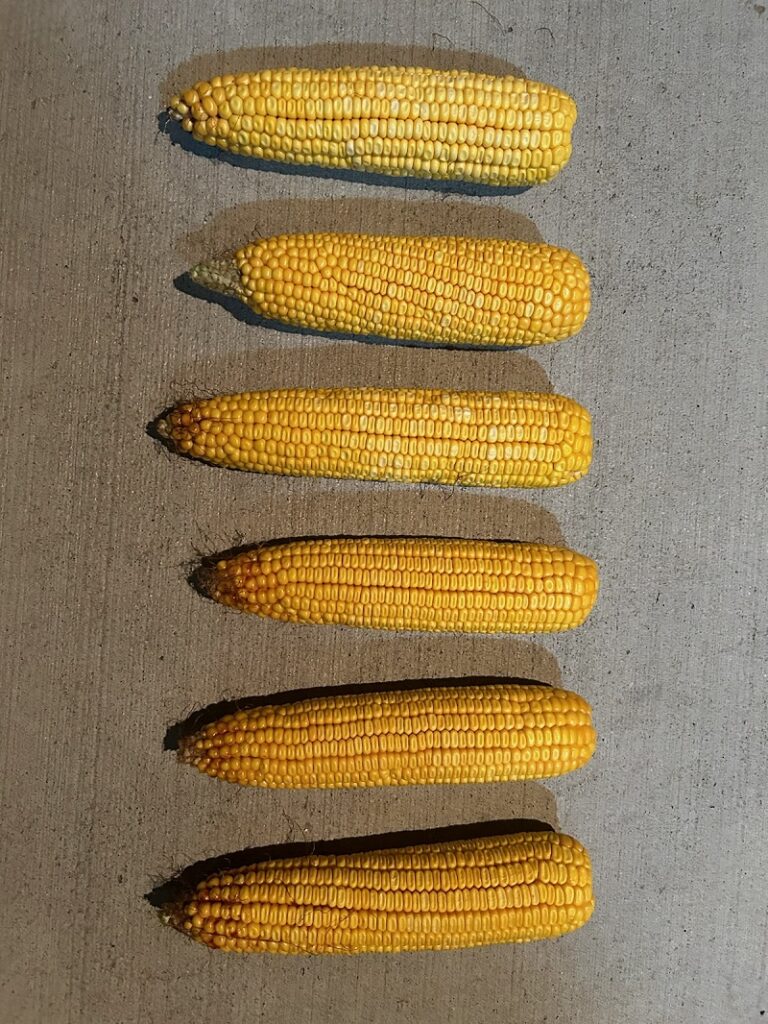
There are still some discussions about how corn is progressing; in general, slowly compared to prior years. September 29 is the next full moon; many will be hoping for a cloudy night so that frost does not arrive and corn can keep filling kernels before black layer. When corn does reach black layer, the grain is fully filled, with no sugar transported in or out of the kernel. This is when the corn plant has reached maturity, and frost will not impact grain yield. The black layer can be seen by removing a kernel from the cob and peeling back the tip of the kernel.
Keep an eye out for stalk rots. Several years ago, some regions experienced a dry spring followed by wet conditions for much of the remainder of the season, causing the corn to have two major “stresses” similar to this year. Stalk rot issues caused lodged corn, especially when strong winds arrived. Be on the watch for weak corn stalks. Now and into the next few weeks (as plants begin to die down) is a good time to check for stalk strength by a push or pinch test. A push test can be done by walking through the field and randomly selecting a minimum of 100 plants, pushing the plant tops away, approximately 30 degrees from upright.
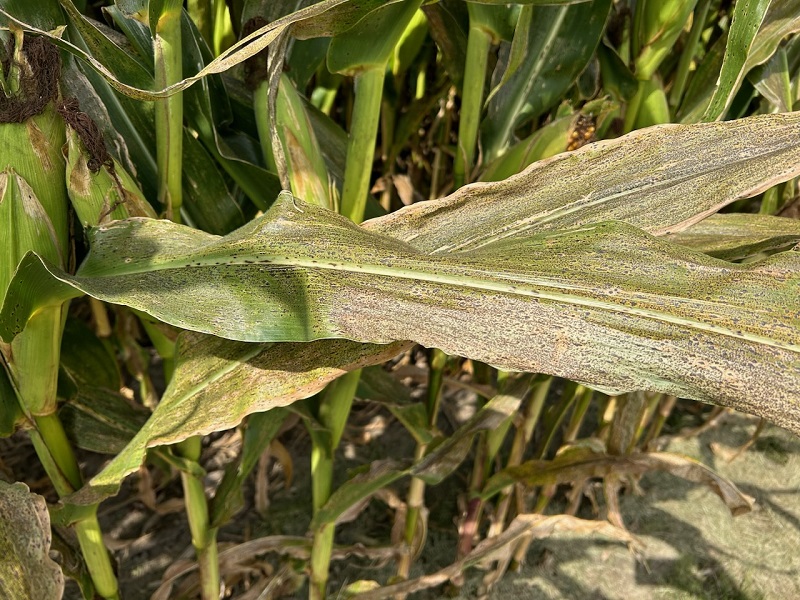
Alternatively, conduct a pinch test where you pinch the internodes of the lower stalk between the thumb and index finger. If the plants do not move back upright, or the stalk is crushed when pinched, the stalk may have stalk rot. The threshold is if more than 10 per cent of plants don’t return to vertical or are crushed, it is recommended to harvest those fields first to limit the chance of plants lodging before harvest. To identify stalk rot in weak stalks, cut the stalk in half and look for discolouration and “hollow” areas. Other signs of stalk rot, even before the push test, can be seen as discoloured leaves that turn brown or gray before senescence.
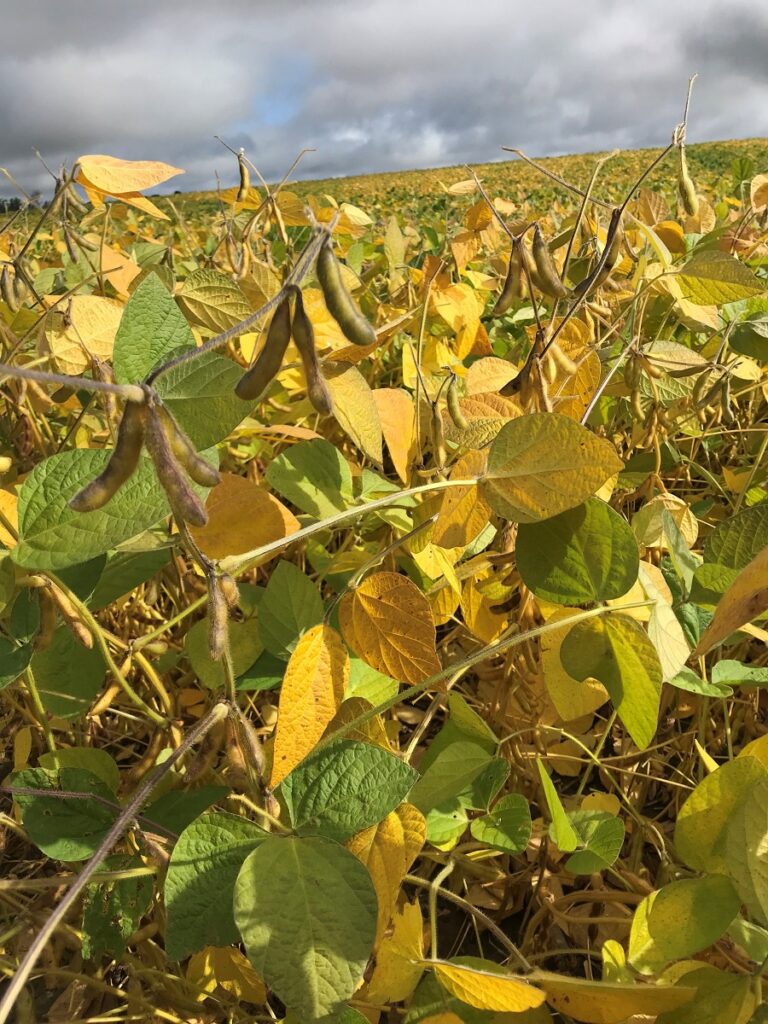
Soybeans
The soybean crop stage ranges across the province from full seed (R6) with all green pods to many fields moving into R7 (beginning maturity), where at least one pod has turned yellow and leaves are dropping quickly. Limited fields have been seen with 95 per cent leaf drop, and pods have reached mature colour (R8). However, like corn, a few more warm, dry days would be welcome.
As a note: this week last year, soybean harvest was beginning in areas of the province, whereas currently, there may be a very limited number of fields that might be harvested of ultra-early soybeans, but harvest this week is not the norm for the 2023 season.
Cereals
Even though it seems like the winter wheat harvest has just finished, it is almost time to begin planting the 2024 crop.
Here are a few things to keep in mind as it approaches.
- Planting date: optimum planting date is key to successful wheat production.
- Seeding rate calculator: having the correct wheat seeding rate, based on a number of calculations, can create a huge economic impact on the profitability of the crop.
- Ontario Cereal Crop Committee Trial results are now all posted for winter wheat.
Soil sampling
Soil sampling should be done at a minimum every three to four years. Soil sampling gives a snapshot of a field’s health when looking at nutrients, pH and organic matter. Soil sampling is a valuable part of the 4R Nutrient Stewardship program (right rate, right time, right source, right place).
Cover crops
It is never too late to think of cover crops. The Cover Crop Decision Tool can narrow down cover crops for each operation based on location within Ontario, desirable traits of a cover crop, planting date, and more. This tool is developed with the help of research that Grain Farmers of Ontario has supported.
September 7, 2023
As school buses begin running again, many are thankful for the warmth and sunlight after a summer with unseasonably wet conditions. Corn and soybeans are progressing towards maturity, with corn in the R5 stage, while soybeans range from R6 to R7. Disease pressure is a common topic this season, with disease pressure ramping up as the season moves closer to fall.
Corn
The corn crop is filling grain this week as it is in the dent (R5) stage, with milk lines ranging from barely there to ¼ milk line. As the season progresses, plants will start to have brown husks, which is a sign that the milk line is getting to be around the halfway mark.
These past warm, sunny days are well received as the heat drives higher daily crop heat units (CHU). Clear, bright days are producing higher solar radiation, allowing the plant to work at peak capacity and adding greater amounts of starch to the kernels. Additional warm weather will help add more mass to the kernels in the next three to four weeks.
Tar spot continues to spread within the corn canopy in southwestern Ontario as there has been heavy dew over the last week. Infection occurred roughly two weeks ago, which would have been two to three weeks since the majority of the fungicide applications occurred. Fungicide applications are effective for approximately two weeks on the crop and have protected the crop from the earlier infection period during the milk and dough stage of the crop. More on this disease can be read in last week’s field observations.
As we have had an ideal disease-pressure environment this growing season, keep an eye out for disease occurrences and severity on the plants. Heavy disease pressure will cause premature death in the coming weeks. Early plant death (senescence) before black layer (physiological maturity) will cause the plant to cannibalize the stalks as the remaining plant sugars are transferred to the cob. Weak stalks with potential stalk rot issues may occur and create harvesting difficulties. Prioritize harvest to those fields that are breaking down early.
Soybeans
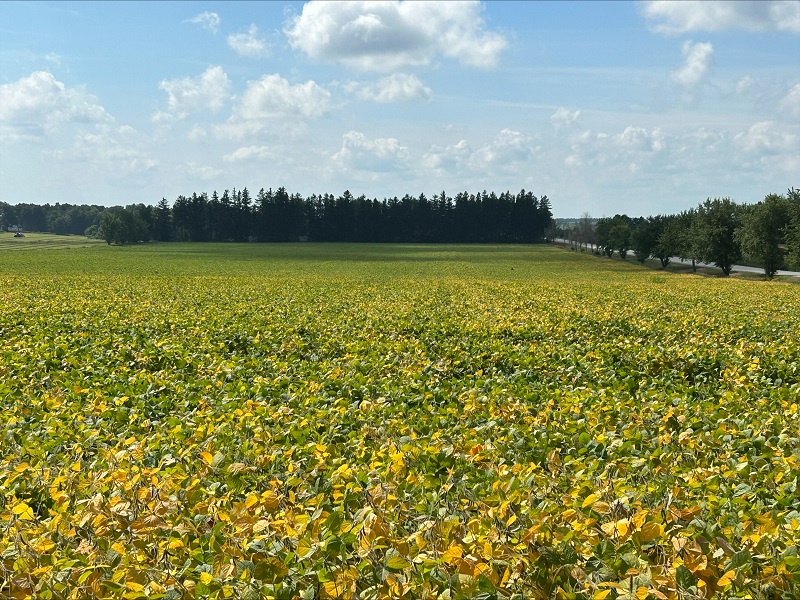
Soybeans are beginning to turn colour across the province. Earlier planting dates and earlier varieties are turning yellow and are at the beginning maturity (R7) stage. Soybeans in the fuller maturity area of the province, mostly above 3,000 CHU, still have many green fields, and the soybeans are still at the full seed (R6) stage. If uneven field maturity is seen, it can indicate that not everything is uniform in the field. Low spots could be greener due to less stress due to more moisture or delayed spring emergence due to waterlogged conditions.
Or in some cases this year, due to delayed emergence from a lack of moisture. Areas of fields that are turning yellow quicker than others need to be investigated, as it may indicate disease or insect pressure; soybean cyst nematode (SCN) populations might be present in the soil or late-season root rots. There could also be moisture deficits in some regions. Scouting throughout the season is imperative. Finding the cause of the problem as soon as possible is important, as trying to diagnose leaf, stem, or root issues is difficult at harvest. Proper identification of problems will lead to better field management in future years.
Dead plants are showing up in soybean fields. Soybean cyst nematode (SCN), sudden death, and even charcoal rot are being reported. White mould is a problem in some cases, even if the field was sprayed with a fungicide, as the flowering window is wide (all of July) and rains were persistent this summer. At this point, nothing can be done to control the occurring diseases, but identifying the disease correctly so the correct action can be taken to prevent the severity of yield loss can be prevented in the future—soil sample for SCN to identify the SCN pressure and race to manage rotation and variety selection. A three-year rotation is advisable for charcoal rot affecting dryer, coarse soils. Adjusting agronomic practices with lower population density or wider rows to create air movement in the canopy variety selection is also critical for white mould.
There seem to be many weedy soybean fields this fall, in many cases due to the dry spring and slow soybean canopy development. This allowed for weed escapes when mid-season rains were abundant to germinate weed seed and little crop competition. Fall weed control in preparation for winter wheat planting is key. A burndown of soybeans might be a good solution to manage weeds before harvest. More information on fall weed control can be found in these two Ontario Grain Farmer articles: https://ontariograinfarmer.ca/2023/09/01/weed-control-for-2024/ and https://ontariograinfarmer.ca/2021/10/15/weed-control-tips/
If conditions do not dry up before soybean harvest, be mindful of compaction, some short-term and longer considerations and some measures to lower compaction can be found here.
August 31, 2023
As the summer edges towards fall, grain crops are progressing towards maturity. Corn can be seen moving from dough stage (R4) into the dent stage (R5), while soybeans are in the full seed (R6) stage. Cereal harvest is ongoing between the rains as growers are looking for dry conditions to wrap up the harvest.
Corn
Fields in southwestern Ontario are hitting the dent stage (R5), while many later-pollinated hybrids are in the early dent stage this week. September will see rapid movement of the milk line as the corn plant closes in on physiological maturity (black layer/R6). Visible factors affecting the health of the plant, such as green leaf loss, hail, frost, or disease, can cause the black layer to form earlier than with the normal maturation process. This is usually referred to as forced maturity. From now until black layer is a critical grain fill period for the corn crop, where the plant is focusing all its energy on filling the kernel. The depth and weight of the kernel will be determined over the next three or so weeks. Maximum sunlight (solar radiation) and adequate rainfall (moisture) will provide the crop with the best opportunity to fill kernels with starch.
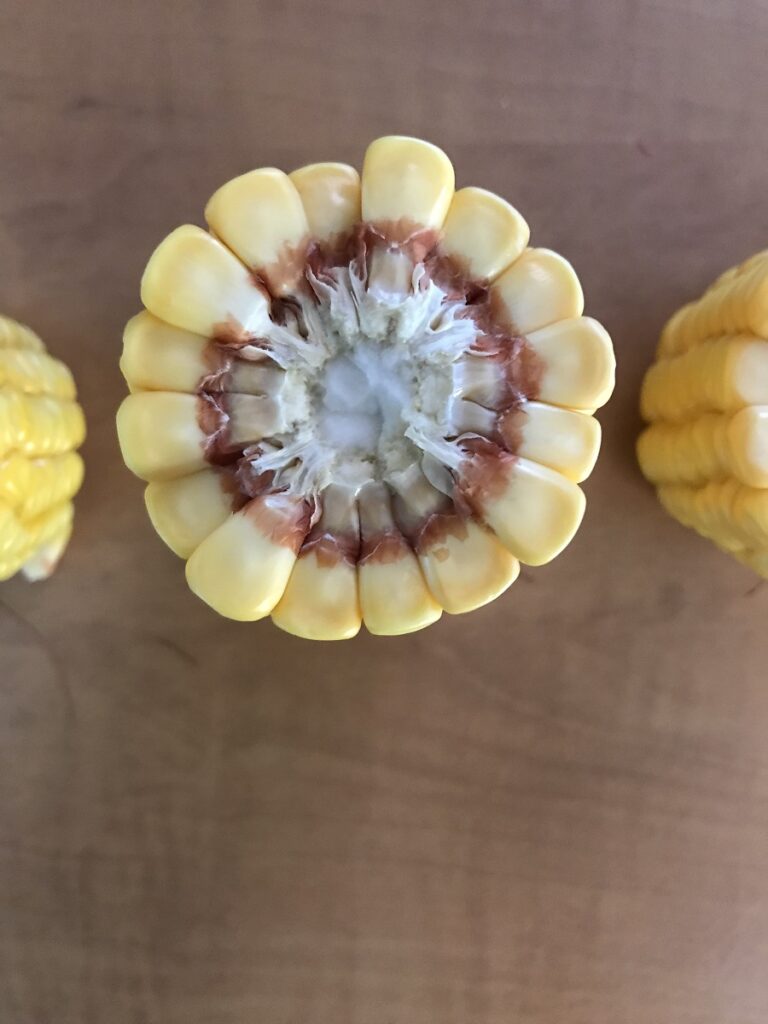
The milk line of the corn kernel is the line on the kernel where the hard starch meets the milky wet part of the immature kernel. The milk line will continue to progress to the tip of the kernel as the corn produces more starch and packs it into the kernel. Once the milk line has reached the tip (sugars converted to starch), the kernel is full, and the black layer is formed, which restricts transfer of sugars in or out of the kernel.
There is some concern building regarding the cool, wet weather delaying the crop progress in southern Ontario. Heat unit accumulation, as provided by OMAFRA in the weekly crop reports, is indicating 200 to 250 fewer crop heat units (CHU) than last year in the deep southwest and along Lake Erie, while the central and eastern regions are in the 100 to 150 chu deficit. The northeastern region from Thunder Bay and west is showing higher chu accumulation of 50 to 100 chu over last year. If cooler, wet weather continues in September, the concern of harvest with delays and wetter grain will be top of mind. As the corn crop continues its journey to maturity, it still needs 30 to 40 days of heat and sunshine to reach maturity, and then we will need some nice weather for dry down. It’s certainly not looking like the ideal early dry fall we had last year.
Tar spot has now been identified in an additional county, bringing the total to six counties: Essex, Chatham-Kent, Lambton, Elgin, Haldimand-Norfolk and most recently Middlesex. Tar spot is also showing up in sprayed fields and the non-sprayed check strips (missed areas of application) and is a good example to show how the disease has established itself in Ontario. Continual ideal disease weather will quickly show how this disease progresses. Fields sprayed at tasseling may begin to show small amounts of tar spot as fungicide control is good to hold off the disease for two weeks after application. Late disease development now is not as concerning as it would be if the disease infection occurred earlier as grain fill is well underway as we are into the dent stage. We will have enough healthy plant tissue and resources in the stalks to finish the grain fill period with limited impact on yield but may compromise standability and test weight near the end.
Corn silage producers will be preparing harvest equipment, as silage will begin in the next few weeks, depending on the crop’s maturity and the silage’s desired moisture. Depending on what is being used to store the silage (bunker vs upright silo), many producers will be targeting between 1/3 and ½ milk line when the plants are in the 65 to 62 per cent moisture range. As the milk line progresses to the tip of the kernel, the ear becomes drier and makes the entire silage sample drier. Correct moisture of silage is required to ensure correct fermentation and storage of the feed.
Soybeans
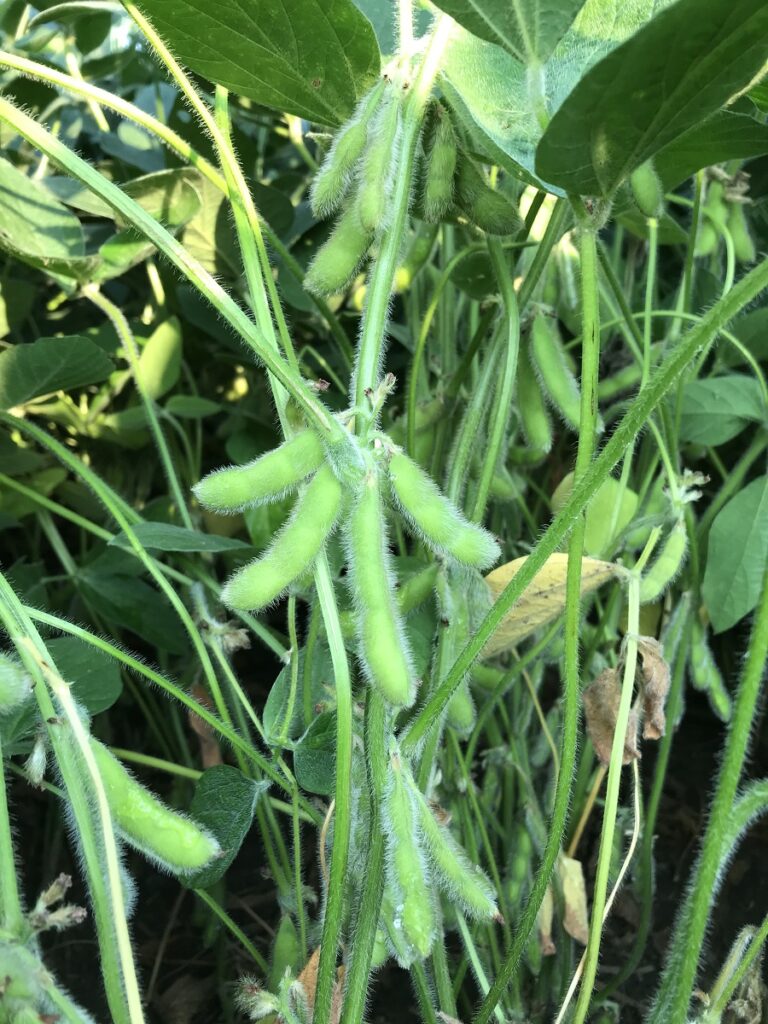
Soybean pods continue to fill this week and have reached the R6 (full seed in top four nodes) stage of development, with the odd field edging towards R7 (beginning maturity) when leaf yellowing can be seen across the field. The weather has also been keeping the soybean crop greener longer as we edge into September. Even as we may be delayed with soybean harvest, the added moisture in August has given more opportunity for more bean fill. Hopefully, when combines get running this harvest, we will see the yield advantage of a healthy crop in August.
Lodging can be seen in some fields, often occurring in the most productive areas of the field where there is high fertility and moist conditions. Also, areas of high plant population, like overlap areas on headlands, tend to lead to lodging, as higher plant competition leads to thinner stems and lanker plants. Lodging can affect light penetration into the canopy and affect yield. Pod and stem disease can also become more of an issue with soybeans lying on the ground in moist conditions. Lodging also reduces harvesting efficiencies as combines need to slow down to pick the crop off the ground.
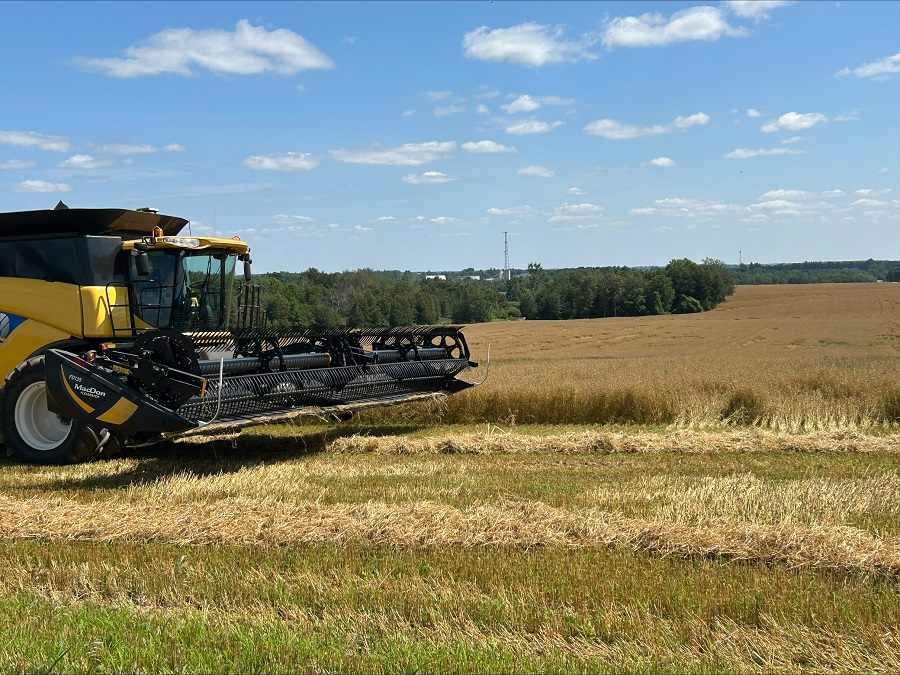
Cereals
Cereal harvest is still ongoing between the rains as growers are looking for dryer conditions to wrap up harvest.
Palmer Amaranth found in Ontario
Palmer Amaranth has been confirmed in an Ontario field in Wellington County. Palmer amaranth is in the pigweed family and can be a very serious problem due to its ability to adapt quickly, high seed production, small seed (making it easily dispersed), competitiveness, and not to mention there are Palmer Amaranth populations that are resistant to nine different modes of action. Learn more about this problem weed, how to identify it, and more.
August 24, 2023
Heavy dews and some rain across the province are causing delays in spring cereal harvest and getting straw baled and off the field (not to mention third cuts of hay). The weather is also causing disease pressure to ramp up in fields.
Corn
The corn crop is in the R4 (dough) stage this week. The odd ear might be showing some denting, as the cobs are a few days from the R5 (dent) stage. R5 is when nearly all the kernels show dents, and the hard starch forms (a milk line will then appear). Within the next week or so, a milk line will appear. R5 occurs about 30 to 40 days after pollination. In another 30 to 35 days, the crop will be at black layer, which is when the crop is physiologically mature and will be safe from any frost threat.
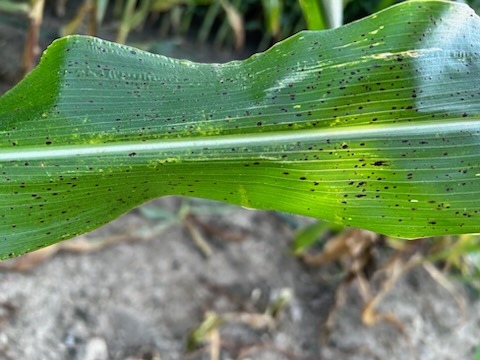
Scouting corn for insects and disease is necessary for growing a good crop. For growers growing corn on corn, scouting for corn rootworm beetle populations and rootworm damage is especially pertinent. More details on possible insect resistance and scouting recommendations can be heard on the GrainTalk Farmer Forum on Corn Rootworm Resistance.
Keep scouting for Tar spot in corn; even though the application window for economical control of the disease is ending, it is still good to know if the infection is present in fields to help manage the disease in future years. In 2021, the disease moved relatively quickly across the province and was identified as far east as Simcoe County. This year, there have been ideal conditions for development, so it could easily be found that far east again or further. Tar spot can impact yield, but it all depends on the severity and timing of infection. Note what management decisions (fungicide applications, hybrids, etc.) are showing a lower severity.
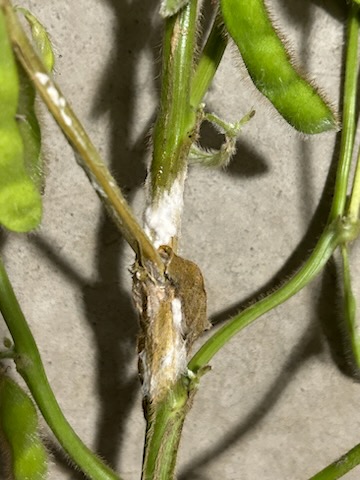
can cause wilting, lodging and plant death.
Peel back the canopy to look for white
cottony mycelia (mould) (pictured) which is a
sure sign of white mould. Sclerotia may also
be found on the inside or outside of stems and pods.
Soybeans
Soybean pod clusters are starting to show this week. Soybeans are still currently in the R5 stage as the pods near the top of the plant do not have beans completely filling the pod. Flowers are hard to find as the plant reaches this maturity point and focuses on filling the pods, not flower development. Sunlight and good moisture conditions over the next few weeks will help set yields for harvest in September.
As reported last week, white mould is causing some issues in some fields. Now is a good time to scout for the disease and see what varieties, fungicide treatments, and management decisions helped to mitigate or lower the severity.
Cereals
After the winter wheat crop has been harvested this year, many growers have taken the opportunity to establish cover crops (quite commonly oats) to help build soil health and help manage emerging summer weeds while hopefully preventing winter annuals and annual weeds from establishing. Timely rains in August have helped the cover crop get off to a good start.
With winter wheat and some spring cereals off, a great time for fall weed control is approaching. For some tips, including effective products, how long to wait until making a tillage pass and more regarding how to control winter annual and biennial/perennial weeds in the fall, read here.
The Ontario Cereal Crop Committee has posted draft performance trial results for Areas 1 and 2. The final results will be posted in August.
Spring cereal harvest has begun (including the far northwestern area of the province).
August 17, 2023
Winter wheat harvest is wrapping up in the shorter growing season areas of the province, while corn and soybeans are progressing well with adequate rainfall this summer. Keep an eye out for disease, as the current weather creates an ideal situation for many diseases to develop.
Corn
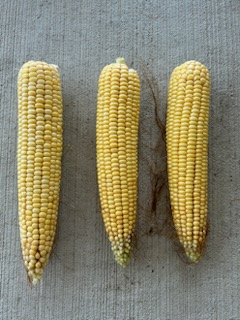
The corn crop is moving from the milk (R3) to the dough (R4) stage. R4 is when the kernel’s inner milky fluid begins changing to a “doughy” consistency as starch accumulation continues in the endosperm.
The current corn heat units (CHU) for Elora is roughly 59 CHU behind the 53-year historical average for the area. Cooler nights and, in general, cooler, wetter days over the summer have impacted accumulation. Many could agree that this has somewhat been a backwards summer.
Now is the time when yield evaluations can begin as kernel development is well underway. When walking fields, it’s easy to see the biggest ear first, but when doing a true evaluation, also look at the smaller ears and gauge the uniformity of the ears in the field. This year there might be some smaller ears showing up as emergence may have been variable with the dryer spring planting conditions and uneven planting depth causing delayed emergence of plants. Dry conditions with purple corn evident in June have shown a delay in development and may have affected ear development and delayed plant maturity. The delayed plants will have smaller cobs, less grain and will be wetter as they are later developed. When doing yield evaluations, take this into account.
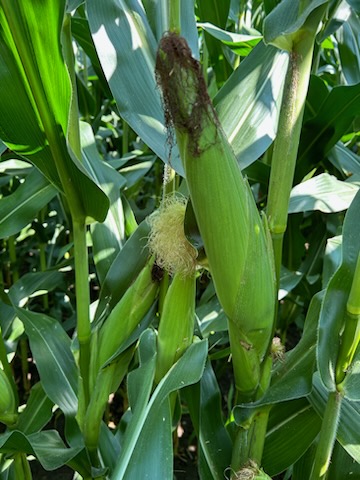
Yield estimate is the number of full ears per 1/1,000 of an acre times the number of kernels on an average ear (kernel rows x kernels per row) divided by how many kernels in a bushel (1/1000). Usually, 90,000 or 95,000 kernels per bushel is a good number to use, but it depends on if there are smaller, shallower kernels (environmental) or if larger kernels are expected due to genetics. For example, a calculation could be 30 ears x 550 kernels/ear divided by a factor of 90, which works out to 183 bu/ac. Remember, it’s just an estimate and depends on the numbers used, don’t look for the best; look for what is there and work with the average of several counts.
Soybeans
Soybeans are staging between R4 (full pod) to R5 (beginning seed). At R5, the plants are beginning to form a seed, with limited flowers remaining on the plants. Some fields are seen to be producing top flowers, which will add pods and potentially allow for top yields. Something to keep in mind with the R5 stage is that at this stage, the plant is less able to compensate for stresses that might be occurring, and about halfway through this stage, the plant will reach its full height while at the same time nitrogen fixation peaks. It is hard to get a yield estimate yet as pods are still forming, and any stress the next week could abort the seed.
Tar spot has now been identified in two more counties this year (Lambton and Norfolk/Haldimand). You can track this disease online at https://corn.ipmpipe.org/tarspot/.
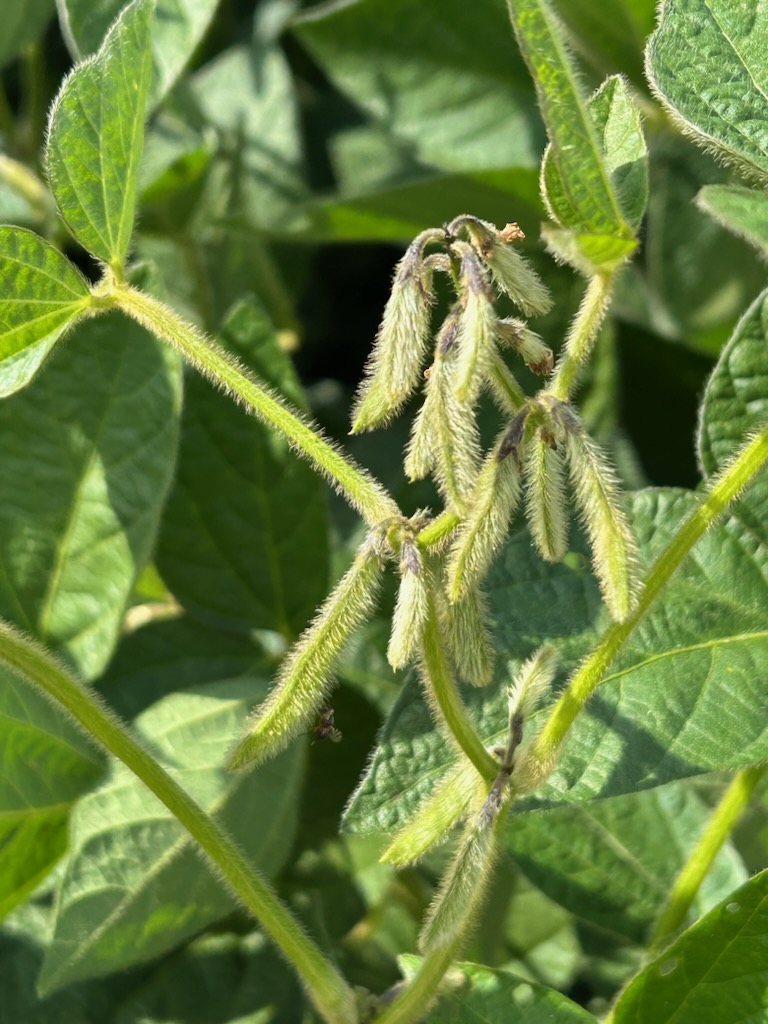
White mould symptoms are starting to become visible this week across the province (unfortunately). Symptoms can be seen as patches of plants dying, with a white fuzz on the lower stems of the dying plants. The infection would have begun 2 to 3 weeks ago on the lower stem, and as the canopies have remained wet since flowering, and with the wet conditions, the disease potential has been increased. As a reminder, white mould spores land on flower petals; the petals then fall and land on the lower part of the plant. The flower is the food source for the mould, infecting the plant. Nothing can be done to stop the disease at this point. Fungicides, if applied, reduce the fungus that develops on the flowers and stem. However, it’s only preventative and provides suppression, and it won’t stop the disease once it is present and growing. Some good news is that infected plants won’t spread unless they are touching other plants (hence patches of plants affected, and hopefully not an entire field). It is good to keep in mind that lower plant populations and wider rows allow for less plant contact and less canopy denseness for disease development and spread. More info on white mould can be found on the Crop Protection Network website. Grain Farmers of Ontario supports the Crop Protection Network.
Root rots are also causing issues in fields, as fields are waterlogged in some areas.
Cereals
Winter wheat harvest is still ongoing in the shorter growing season areas of the province; however, closing in on the final stretch. Yields are still coming in as average to above average, with good quality. Some have reported lower straw yields than in past years.
The Ontario Cereal Crop Committee has posted. The final results will be posted in August.
Spring cereals are in the ripening and dry down stage and will soon be ready for harvest.
August 10, 2023
Winter wheat harvest grinds on as heavy rains cause delays to get the final acres off. On the bright side, yields for winter wheat are average to above average. This certainly seems to be an abnormal year, moisture-wise at least. Rains at this time of the year are beneficial for corn and soybeans and will help make yield. Overall, the corn and soybean crops are looking exceptional.
Corn
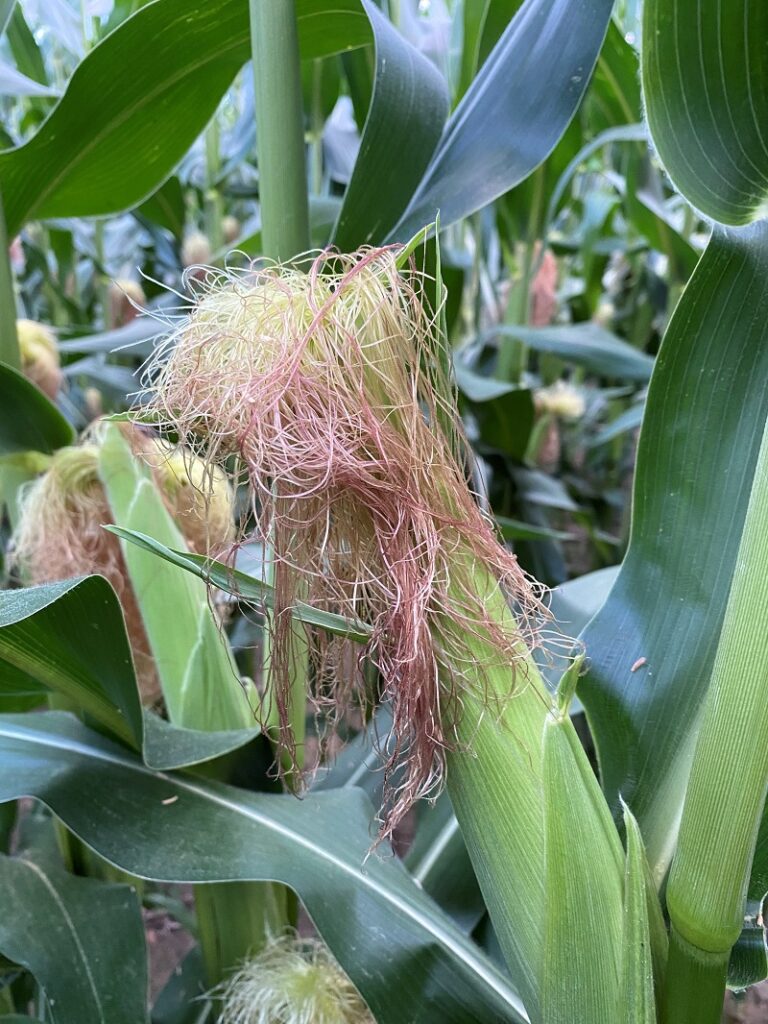
With the additional rainfall received across most of the province, after pollination the corn plant has moved to the blister (R2) stage to early milk (R3) stage as it is just starting to show some yellow colouration on the kernels, however, some later planted fields are still in the silking (R1) stage. On the later planted fields, fungicide applications may still be ongoing in order to protect plant health as weather conditions are still conducive to disease development. As an aside, tar spot has now been confirmed in three counties in Ontario; Essex, Chatham-Kent, and Elgin. More information on tar spot can be found in the Grain Farmers of Ontario tar spot Agronomy Alert.
Due to the early season drought, there are some interesting things to find in the field. Looking closely at the corn plant, in some regions, drought stress can be seen on the plants, from lack of moisture at the beginning of the season. This is showing up with internodes being short on the lower half of the plant with larger internodes above the cob. This would indicate stress at the V5 to V8 stage, and better growing conditions afterwards. Ear husks are short on plants in water limited areas, with some cobs that have exposed tips. Drought conditions shorten the husk development, and later rains allow for ear length to extend longer than normal. Ear length is determined around V12 and later. The drought helped the plant build better stalk strength with shorter stalks, however the exposed tips are not good as insects and birds eat the tips ( this is already being seen in fields), impacting yield, and potentially quality closer to harvest.
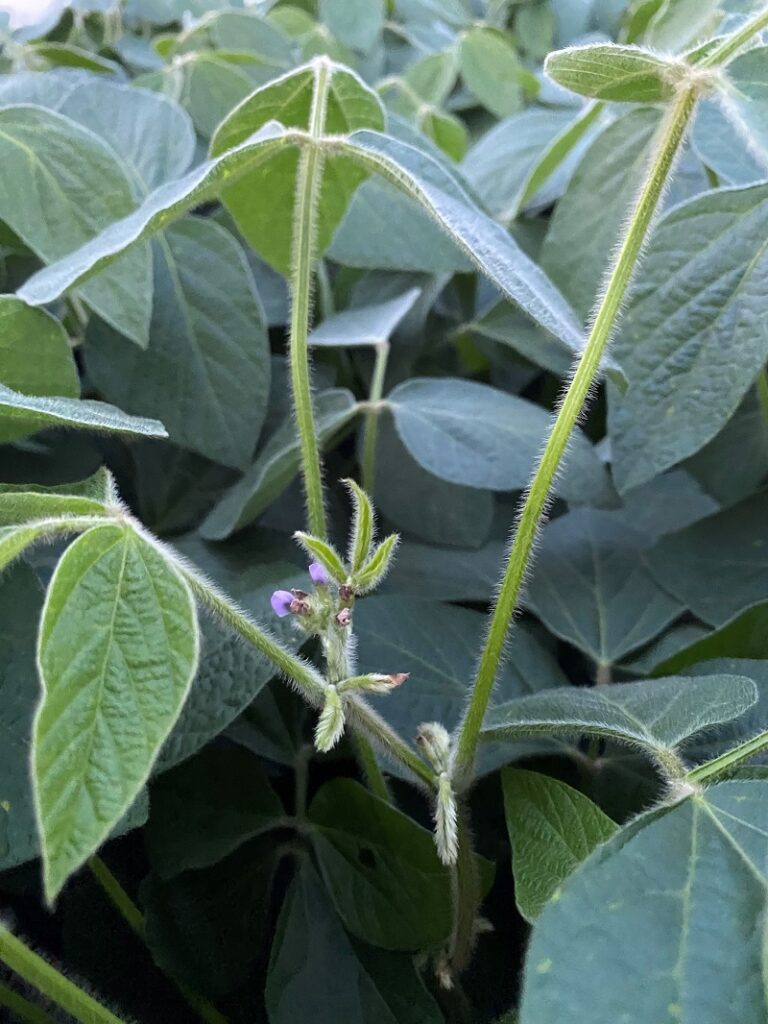
Soybeans
Soybeans are currently staging around the full pod (R4) to beginning seed (R5) stage.
With adequate moisture the soybean plant is elongating quickly, allowing for more vegetative and reproductive capacity. Plants have a higher chance of lodging as they get taller. Lodging can cause harvest troubles, and diseases can become more of an issue on lodged plants (commonly white mould), reducing yield. Lodging is often seen in the highly productive, moist areas of fields.
Cereals
Winter wheat harvest is approximately 80 per cent complete, province wide, with good yields (some reporting well over 110bu) and quality. Prior to recent rain, moistures were in the mid to high teens. With another good weather window, harvest will wrap up quickly.
Oats and barley are ripening and will be harvested within the next few weeks.
August 3, 2023
The corn crop is pollinating, soybeans are flowering, and winter wheat is being harvested; we can’t ask for a better week in Ontario agriculture. But it’s not all roses — be on the lookout for pests and disease in the crop and be prepared to take action if warranted.
Corn
Corn is getting a lot of attention this time of year. Fungicide applications are occurring on fields at high risk for tar spot or Gibberella ear rot. Applications are being made via air or ground (where conditions allow).

The timing of a fungicide application to reduce the potential of Gibberella ear rot (and, in turn, DON) must be completed when fresh silks are present and before they have begun to turn brown. Brown, dry silks are no longer attached to the ovule and do not allow the ability to travel down the silk channel to provide fungicide activity. There is typically a seven-to-ten-day window of fresh silks to spray. Due to early season stress and variable soil types in fields, we see high silking variability within the corn stand. The application window will be narrow since some areas will have dry silks when the last plants are silking. Recent research by Dr. Dave Hooker shows that the late silking plants seem to be at a higher risk for DON than earlier silking plants in the row. This could potentially be due to the potential of higher risk with the later pollinating plants as the pollination window is pushing later, putting the plants in a more ideal environment with temperature and moisture conditions later in the season that favour the development of DON.
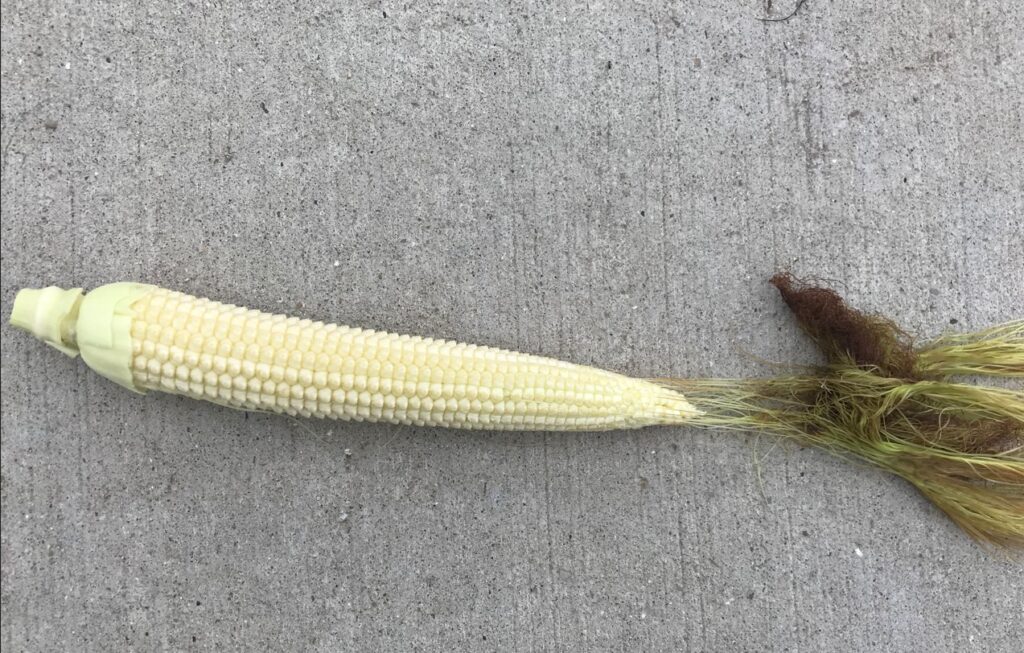
While most of the corn crop is in the later R1 (silk) stage, some earlier planted fields or earlier hybrids are at the R2 (blister) stage. This seems to be a week later than normal, and if cooler conditions continue, we will see corn maturity (black layer) push back a week later this fall unless the later summer/early fall remains warm with higher heat unit accumulation.
An ear shake test reveals 99 per cent pollination on this ear in southwestern Ontario. Once dry silks appear at the tip end as brown silk, husk the cob and shake off the silks to reveal the potential kernel count of 16X50. The potential is good, but drought stress, nutrient loss, disease, and insect feeding can still take the ear tip back, and kernels can be lost. In the last picture, the silk can be seen, still attached to the unfertilized ovule.
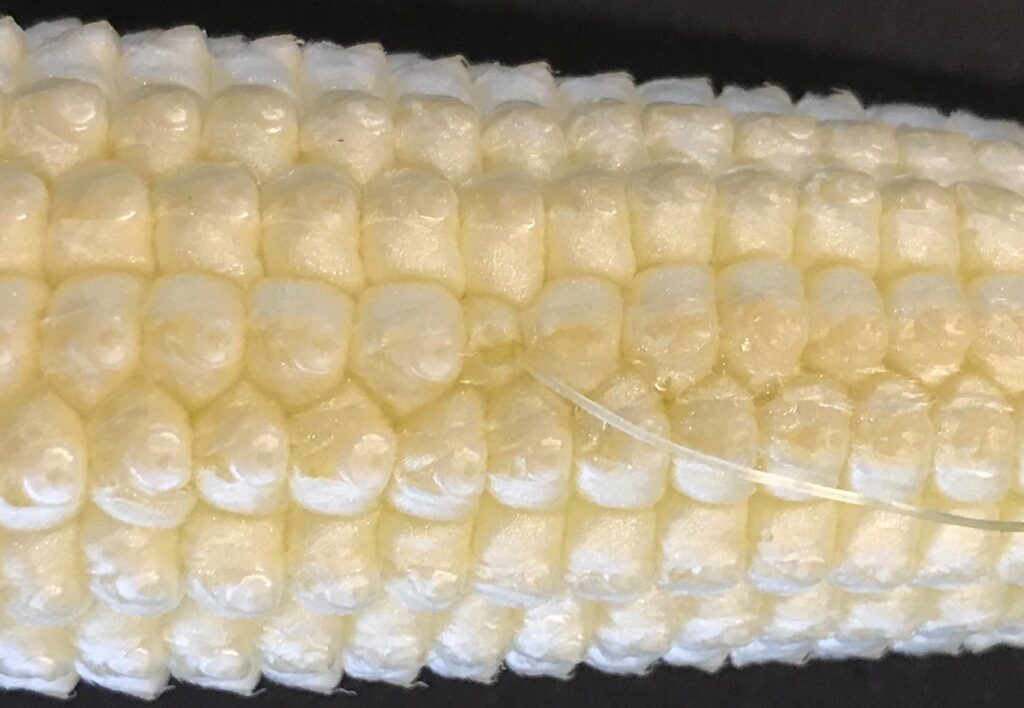
Western bean cutworm (WBC) counts are trending higher this year than the previous three, with peak moth flight anticipated to be this week or next. Read more on this pest, scouting for it and control options in this Field Crop News article.
To learn more about the pests and disease to watch for this year, tune into the recently recorded Grain Farmers of Ontario #GrainTalk webinar.
Soybeans
Soybean fields are staging at the R2 (late bloom) to R4 (beginning seed). The window for white mould control is closing for many fields as flowering is coming to an end for most of the plant. Newly formed top growth of the plant will continue to produce flowers as soybeans in Ontario are indeterminant and will continue to flower on the top as new nodes form and pods develop in the canopy below. And as more flowers are being developed on the plant, full yield potential has not been realized yet. With adequate soil moisture this month, seed sizing should be good.
Even with heavy rains, aphids are still showing up in some fields at high populations- be on the lookout.
Cereals
Winter wheat harvest continues, with approximately 45 to 55 per cent complete provincewide (the southwest has completed harvest while the remainder of the province is in the midst of harvest). Yields are average to slightly above, with moisture in the mid to high teens. As harvest continues, remember to grease bearings and oil chains – the last thing anyone wants is a combine fire.
Now is a great time to take soil samples! Remember that removing straw also removes nutrients. Be sure to account for top yields that have been harvested off fields these past few years and fertilize accordingly to keep soil test values where they need to be.
It is also a great time to plant cover crops after wheat harvest. For abundant information on cover crop recommendations, the Midwest Cover Crop Council has a Cover Crop Decision Tool with Ontario recommendations. Grain Farmers of Ontario partly funded the tool.
Spring cereals are in the grain fill period, with harvest approaching within the next few weeks.
July 27, 2023
Heat and moisture this past week have pushed crop development along to where we are starting to see corn hitting the VT/R1 stage with tassel and silk fully emerged. Pollination has started and will be occurring over the next week. Soybeans have also benefited from the heat and rain, with crop canopies growing to double in size over the past 10 days. Wheat is steadily being harvested across the province, with areas in the south getting close to completion, while midwestern and eastern Ontario are starting at harvest this week between rain showers.
Corn:
Continual wet weather has many looking for the start of disease development. As we are at the beginning of pollination, we will see lots of aerial and ground rigs applying fungicides on corn over the next week.
Tar spot has been identified in Ontario already this summer; check the live map for details. This disease has contributed to a loss of yield in past years, dependent on timing and the severity of infection. Now is the time to scout fields for this disease and to take action before the severity increases. To learn how to scout and manage this disease, read the Grain Farmers of Ontario Agronomy Alert and watch the Grain Farmers of Ontario #GrainTalk Webinar. Tar spot can be managed through hybrid selection and with fungicide applications. Fungicide application can occur between V8 and R4, but tasseling (VT) and silking (R1) is the optimal and most economical application timing as it is also the application window to prevent ear infections from fusarium and reduce DON severity. Other common leaf diseases like Northern corn leaf blight and Grey leaf spot that favour current moist conditions can also be controlled at this time. If spraying early in the season, before VT, continue to scout for diseases, as infection can still occur two to three weeks after fungicide application. Check the table “Fungicide Efficacy Table”
to review specific disease control ratings by specific fungicide products.
Gibberella ear rot is the precursor to DON* infection in corn. Fusarium graminearum, which causes Gibberella ear rot, typically infects the plant via the silk channel during warm, humid, rainy days. Current weather conditions have caused, in many areas, higher humidity in corn fields. Rainfall during silking time will provide ideal conditions for infection. Fungicide applications during the VT to R1 growth stage can help lower the severity of infection but must be applied to fresh silks to be effective. More info on DON in corn can be found in the Ontario Grain Farmer magazine.
Soybeans:
With soybeans at full bloom (R2), we are starting to see small pod formation on the first nodes located at the bottom of the plant. Also noticeable is the short length of the first few internodes due to our earlier dry stress conditions. With the last three weeks of more than adequate rainfall, the newer internodes at the top of the plant are much longer, adding to the bigger crop canopy than a few weeks ago. It looks like we will have a strong bottom stem with lower pods on the first few nodes. If this weather continues, a floppy elongate top may result.
Cereals:
Winter wheat harvest has been rolling along this week as wheat maturity progress to the north and east of the province. Grain harvested at maturity has come off with very good quality. Those fields caught with a few rain showers have seen grain quality degrade. Trials on the impact of harvest delay were done in 2021, showing the impact of yield and quality.
July 20, 2023
This week, there have been timely rains in some portions of the province while other areas need respite. Hail, lodged crops, and more will make timely management decisions key in the coming days and weeks. Be on the lookout for disease, as it becomes more prominent as wet weather persists. Wheat harvest creeps forward around rainstorms.
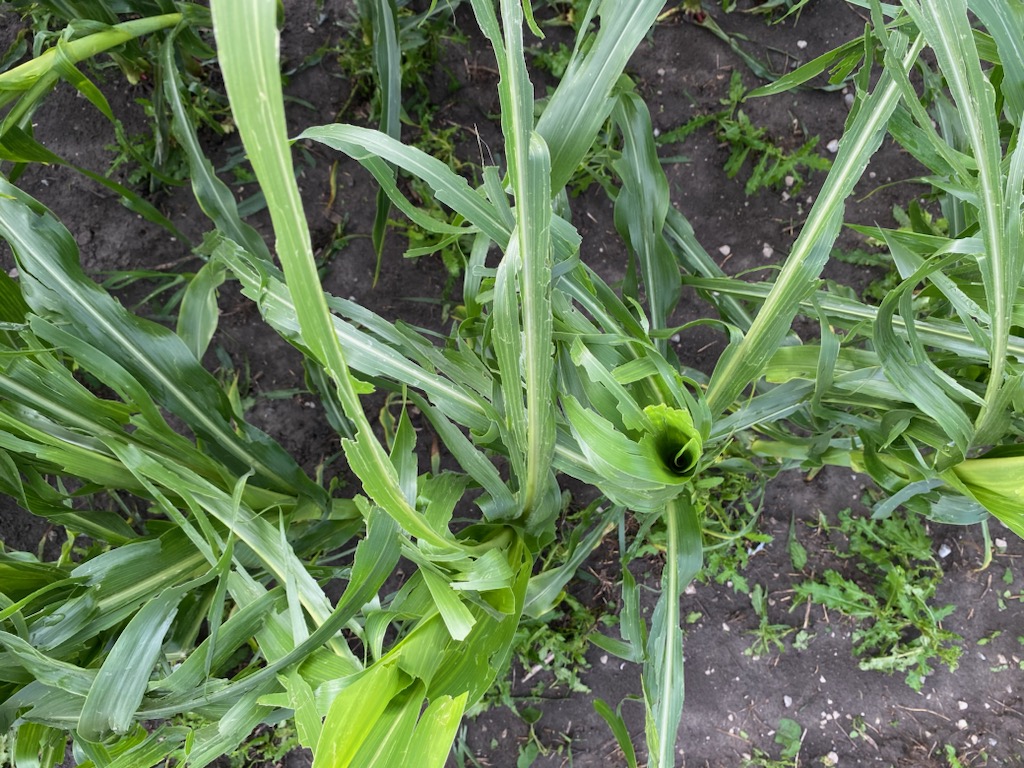
Corn
It has been a wild week/weekend for some corn fields, with heavy wind lodging corn and hail shredding plants. Here are some things to know regarding these two topics.
Lodged corn: Potential causes can be narrow rows with higher populations, looser wet soils with rapid plant growth creating large biomass above ground but not enough root growth. Brace roots are not fully developed at this stage to anchor the plant. Another point to consider, especially on corn-on-corn ground, could be corn rootworm feeding causing the lodging issue.
What now? As long as the stalk is not snapped or broken, it will stand back up eventually; however, it will be goosenecked and will make harvest challenging. Be sure to take note of which hybrids were affected. Be sure to take a look at the roots to make sure it was, in fact, the wind causing the lodging and not rootworm that have excessively chewed root. For more info on corn rootworm and potential resistance issues, view the Grain Farmers of Ontario Farmer Forum.
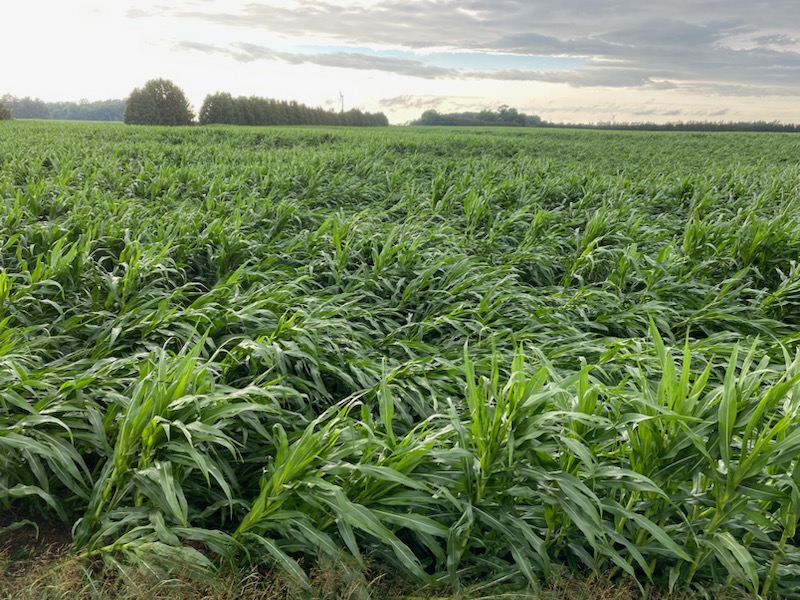
Hail: Some areas received marble-sized hail or smaller, causing intense shredding of plants. If corn and soybean fields have been impacted, fungicide applications are key to plant health to help limit disease where tissue has been damaged. If there are severe hail issues, farmers should open a claim for production insurance with Agricorp.
Conditions are prime for disease development in field. Diseases that are being seen currently include Anthracnose leaf blight (tan lesions with dark borders can be individual or join to get larger). At this point, this disease is still a minor concern as it is only being found on lower leaves, and those will die off as the season progresses as the leaves dry down.
Tar spot has been detected in Ontario. An easy way to identify tar spot is it looks like tar and does not come off if wetted and rubbed. If it is being found on the lower leaves, the infection is coming from previous years, as the pathogen is in past plant matter. If it is being found on the newer leaves, it is a new infection to the field. No-till, corn on corn, and wet conditions with high humidity all increase the risk of tar spot. The Tarspotter app is a great resource for assessing the risk level of disease development!
With warm, humid conditions this summer, other leaf diseases like Northern corn leaf blight (NCLB), grey leaf spot (GLS) and eyespot may also appear. A major ear disease infection to watch out for with these ideal conditions is Gibberela ear rot, caused by the fusarium infection during the silking period, which can produce the DON toxin. When controlling corn diseases with fungicides, be sure to know which diseases are being targeted and select the correct fungicide. Products containing active ingredients such as metconazole, prothioconazole, or pydiflumetofen at the correct rates can suppress DON levels. Learn more about other diseases and more in the recent #GrainTalk webinar on pests and diseases to watch for in 2023.
Corn is currently staging in the V10 to V12 (10 to 14 leaf tips), with VT (tassel emergence) just around the corner. When a plant is dissected, and inner leaves are unfurled, if there are 3 to 4 more leaves before tassel emergence, the plant will need 150 to 200 GGD. At 50 GGD per leaf, we will need another 10 days before tassel emergence. In general, the season is delayed, with the Ridgetown area being 110 CHUs behind the 11-year average. Smoke from wildfires is still creating a haze and could be impacting the solar radiation that is reaching crops, resulting in slower plant development.
Soybeans
Soybeans have also been impacted by hail; a fungicide should be applied to help protect the plant from disease if warranted.
Spring-seeded crops are in the R1 to R2 (beginning bloom to full bloom).
Fungicide applications are occurring or will be shortly if farmers choose to do so. Farmers are applying fungicides to help manage disease and potentially increase crop yield. Many fungicide applications are to help control white mould, which can affect the yield of soybeans. Certain varieties are more prone to infection, as are fields that were planted early, have a narrow row width, and have high plant populations. More information on white mold can be found via the Crop Protection Network, which Grain Farmers of Ontario supports.
Double-crop soybeans have emerged nicely as there have been ample amounts of moisture for the seed to imbibe water, germinate and emerge.
Grain Farmers of Ontario has developed an app with OMAFRA called Pest Manager which allows you to identify, map, and find integrated management options for common weeds, insects, and diseases in corn, soybeans, and cereal crops. Any pesticide use information in the app is specific to Ontario only, and users should always read the product label before use.
Be aware of off-target movement of herbicides. Learn more about how to prevent drift and what should be done should it be suspected here.
Resistant ragweed is becoming more of a dinner table discussion across the province, as there are several counties having single to multi-resistant ragweed. Learn more about this weed and how to control it better here. If you think you have resistant ragweed, be sure to speak with your agronomist.
Cereals
Wheat harvest has been very stop-and-go this season so far. Moisture levels reported ranged mostly at the higher end of around 16 to 20 per cent, with lower moisture earlier this week as there has been some weather that has allowed for further drying. Yields have been average, but there is a threat of lower test weight, falling numbers and overall quality if this crop sits out in the field too long.
Hail affected cereal crops as well, as wheat kernels were threshed out and found lying on the ground.
With lots of rain and humidity, it is worth taking a walk through mature wheat fields which are ready for harvest to look for sprouting and disease pressures and prioritize which fields to harvest in order to keep the good quality wheat. Separate grain that could lower your wheat grade.
There have been many ups and downs this season already, and we aren’t even halfway through it yet. Take care of your mental health; there are numerous resources available should they be required.
Cover Crops
With the wheat harvest ongoing, now is the time to be thinking of cover crops. The Midwest Cover Crop Tool uses Ontario research to select the best cover crops for each operation based on location, farm goals and farm characteristics. This tool is supported by Grain Farmers of Ontario.
July 13, 2023
Corn is progressing across most of the province, as are soybeans. However, for some regions, the rain tap could shut off as there are very wet soils in some areas causing issues with air-to-root exchange. The winter barley harvest is mid-harvest, while the winter wheat harvest is just picking up steam between the showers.
Corn
Corn is progressing rapidly with the rain and heat received. More advanced fields are starting to see tassels (VT) breaking through, with full tassel shortly. Due to the early June drought and recent excessive rains, crop stress is appearing as uneven fields are showing soil structure variability.
In some dryer pockets of the province, moisture will be imperative as drought stress during pollination (next two to three weeks) will limit the ability of the crop to initiate kernel development. Fewer kernels mean fewer bushels per acre.
Insects can pose a challenge as well in the coming weeks to months. Western bean cutworm have arrived in fields. Now is the time to check traps and scout for egg masses. Trap counts will increase in the coming weeks.
Diseases are showing up in the region, be on the lookout for tar spot (recently identified in the Rodney area), northern corn leaf blight and gray leaf spot. The regions with continual rainfall will have ideal conditions for disease development with the excessive leaf wetness and humidity this season. Fusarium infection of the silk channel resulting in DON development over the grain fill period will be another concern as the pollination period occurs over the next two weeks. Prevention of DON and tar spot will be on the minds of corn growers in southwestern Ontario. If using a fungicide, ensure it is labelled for the disease you are targeting.
A Grain Farmers of Ontario GrainTalk Webinar was recorded this week with guests Tracey Baute and Albert Tenuta from the Ontario Ministry of Agriculture, Food and Rural Affairs. Listen to their insight on possible pests and diseases to be on the lookout for this summer.
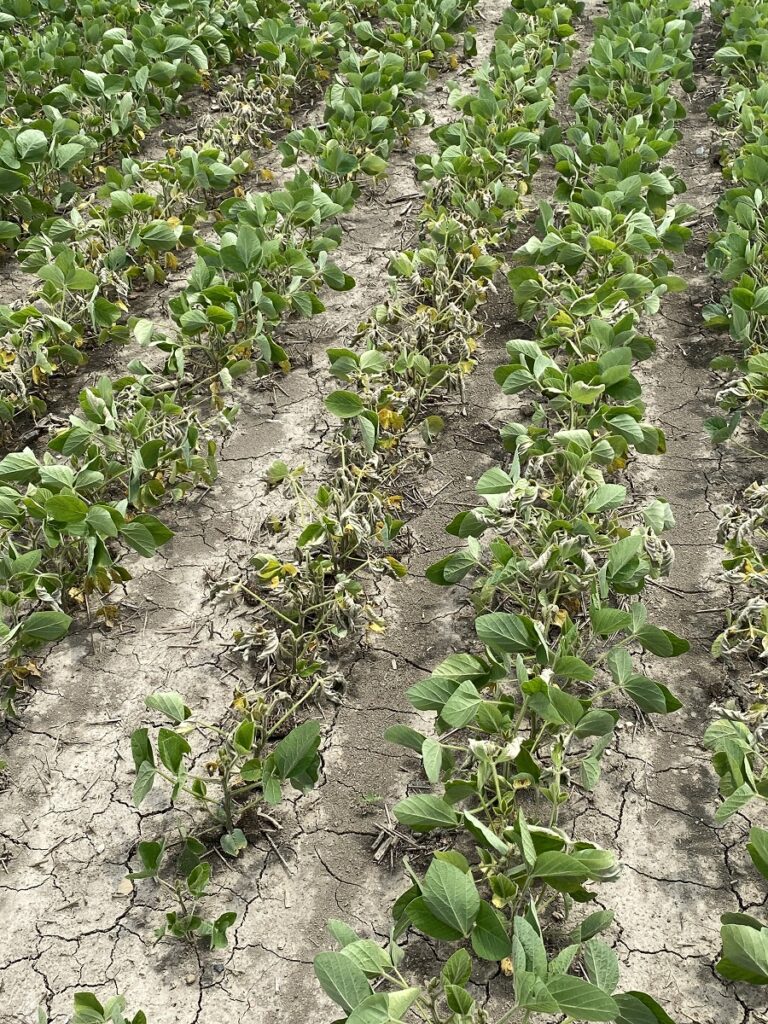
soils that have plants looking like they are
affected by drought.
Soybeans
Southwestern regions saw three to 10 inches of rain over the past two weeks. Waterlogged soils set the stage for root rots. Be on the lookout for classic wilting symptoms that tend to show up later in the day when temperatures increase (as plants are trying to take up more water and can’t), with clay soils being the first to show these symptoms. Get digging and look for Phytophthora and/or Fusarium root rot. In the future, root rots can be better managed by crop rotation, seed treatments and, in the case of Phytophthora, variety selection.
Soybeans are growing quickly. Now that they are past the third trifoliate, branches and additional trifoliates develop quickly. Flowers are now forming, and most fields are at the R1 stage (first flowers on any node) to R2 (full flower – when there are flowers at the upper one or second node). Soybeans grown in Ontario are indeterminate type; they will continue to put out more flowers as the plant continues to grow, developing pods on the lower part of the canopy and continuing to produce flowers as the plant continues to grow.
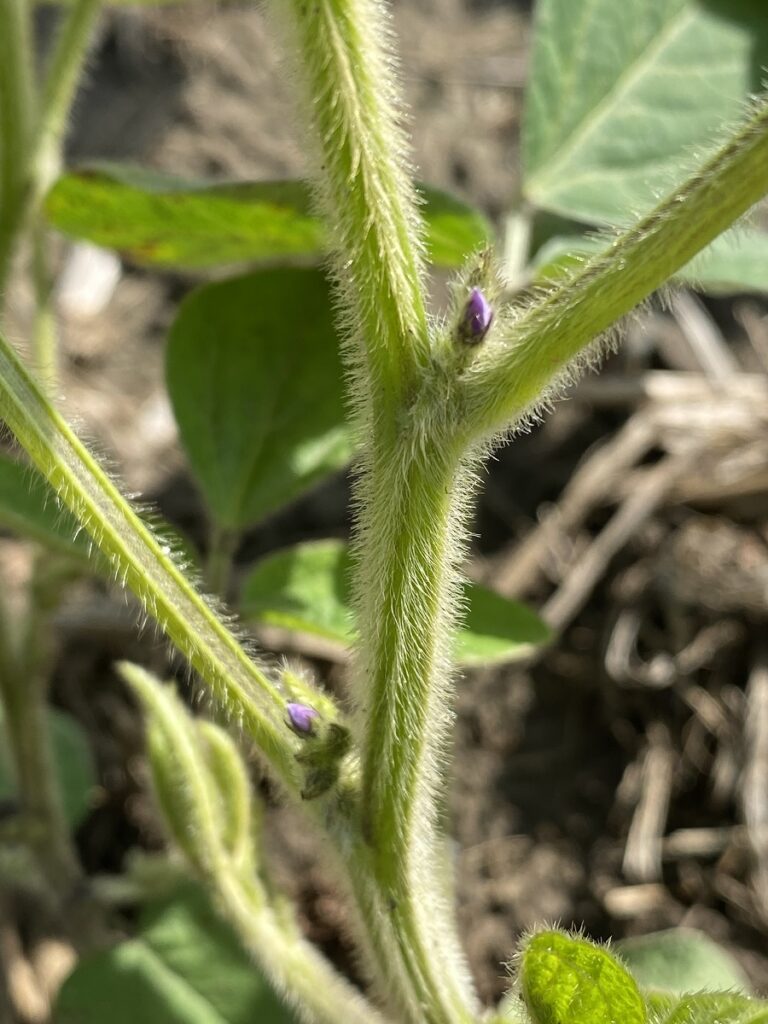
Dry weather for soybeans now at flowering is okay, as any loss in flowers can be made up in the next month. Dry weather during flowering limits white mould infection of the open flower. Rain for pod fill in August will be needed to make the crop.
Soybean cyst nematode (SCN) cysts are visible right now. Look for areas of stunted plants/poor canopy and/or chlorotic growth over the next one to two weeks. In most areas where soybeans are located, there are nematodes. To see what level of SCN is in soil, there is a FREE test that can be done; if you are interested, contact albert.tenuta@ontario.ca
Be on the watch for white mould, two-spotted spider mites, aphids and more. To explore further, watch the recent GrainTalk Webinar.
Cereals
Winter wheat is ripening across the province, with the deep southwest firing up combines (when it isn’t too wet to operate). Reported yields so far are around average. Be on the lookout for black point in winter wheat, caused by pathogens when it is warm and wet during grain fill and ripening. There are no mycotoxins associated with this disease; however, downgrades may be possible due to kernel discolouration. Be sure to scout and harvest affected fields first.
July 6, 2023
We’re only two weeks into summer, and it is proving to be the summer of extremes across the province. Some areas are waterlogged, and others are screaming for rain. Crops are progressing rapidly with the recent heat; corn can be seen at V8 to V12 (10 to 14 leaf tips) stage, while soybeans are R1-R2 (beginning flower to full flower), and winter wheat harvest will be starting as soon as some fields dry down.
Corn

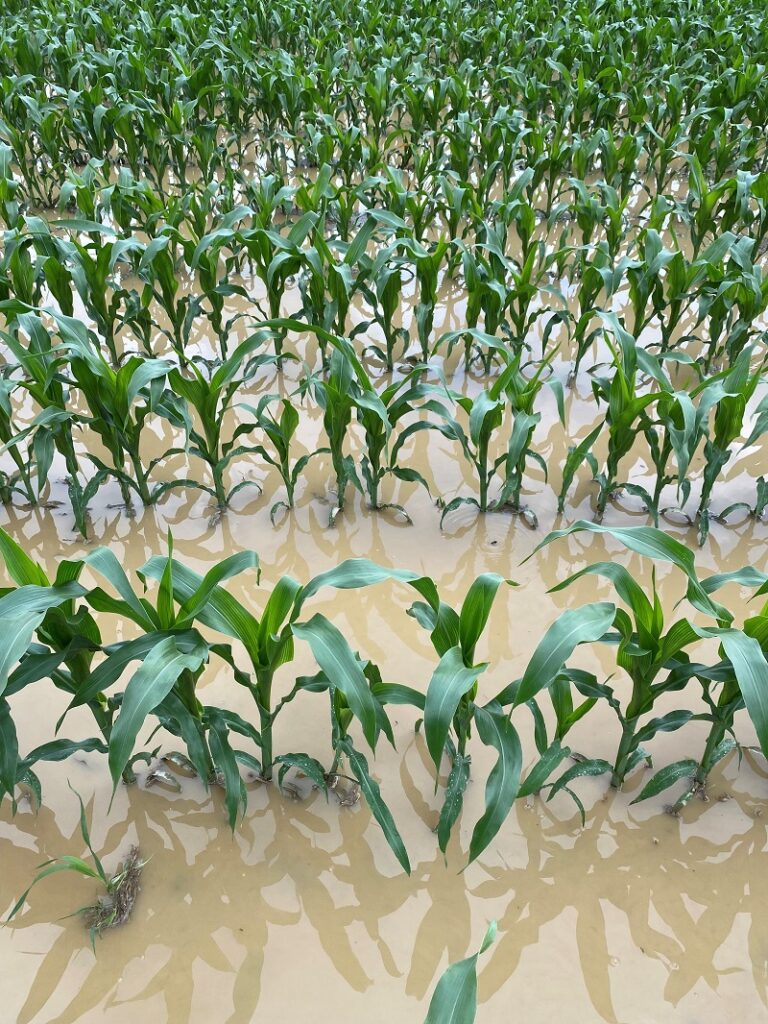
There were some extreme rainfall amounts in the southwest area of the province this past weekend, with some areas receiving upwards of six inches over a couple of days, creating massive amounts of flooding. Crops are waterlogged, meaning the disease triangle has been well set up for future disease development. The disease triangle consists of an interaction between the environment, pathogen and host, and disease can form when all three are present. One disease that should be on everyone’s watch list this year is tar spot. The ideal conditions for developing this disease are temperatures between 15 to 21 degrees Celsius and high humidity (greater than 75 per cent) for seven to eight hours. Saturated soils (like many areas are seeing) and leaf wetness can cause the disease to spread quickly. Overall, it is wet/dry cycles that seem to drive development. Tar spot has been spotted in 2023 in the U.S. states of Iowa, Kansas, Missouri, and Nebraska so far. How long until Ontario has its first confirmed sighting this year? For more information on this disease and how to manage it read the Grain Farmers of Ontario tar spot Alert.
Crop heat units (CHUs) are still behind in some areas, but this week of warm temperatures during the day AND at night will help accumulate CHUs, bringing CHU accumulation closer to average. The max number of CHU per day is 35. If there are 30-degree Celsius days (16.5 CHU accumulated) combined with 25-degree Celsius nights (18.5 CHU accumulated), that is when the max CHUs are achieved. Warm nights are critical to maxing out CHUs. Earlier this week were the days when some say, “You can hear the corn grow.”
Soybeans
Soybeans across the province are in the R1 to R2 stage. Stage R2, where there is an open flower on one of the top two nodes on the main stem, is full bloom. Plants will typically stay in the R2 stage for eight to 12 days, at which time small pods will begin to form, transitioning the soybean into the R3 stage. Pay attention to waterlogged areas in the next week or so; signs of wet roots may show up as the bottom leaves turn yellow or soybeans die. Excessive moisture can create uneven fields as low areas and compacted areas cannot achieve proper gas exchange in the root zone. Expect disease pressure to increase significantly in a short time frame.
Fungicide applications are occurring or will be shortly if farmers choose to do so. Farmers are applying fungicides to help manage disease and potentially increase crop yield. Many fungicide applications are to help control white mould, which can affect the yield of soybeans. Certain varieties are more prone to infection, as are fields that were planted early, have a narrow row width, and have high plant populations. More information on white mold can be found via the Crop Protection Network, which Grain Farmers of Ontario supports.
Grain Farmers has developed an app with OMAFRA called Pest Manager which allows you to identify, map, and find integrated management options for common weeds, insects, and diseases in corn, soybeans, and cereal crops. Any pesticide use information in the app is specific to Ontario only, and users should always read the product label before use.
With wheat harvest just around the corner, double-crop soybeans are a common conversation in some areas. If aiming for double-crop soybeans, seed supply on early season beans will be needed. The date of wheat harvest and the field location will determine a lot. Aim for seed maturity that is at least one full maturity group shorter but check with your seed dealer on what they suggest and what is available. The seeding rate should be increased to at least a population of 250,000 seeds per acre. Planting date should be considered, looking at frost dates, as the yield potential will drop considerably if soybeans are planted too late; early to mid-July planting dates are ideal. Be sure that the soybeans are going into good conditions. July 10 is a good date for planting, maybe July 20 in the deep southwest, but it is a risk at any date as success will be determined by weather conditions allowing for quick emergence and proper rains for plant development before the first frosts. The management of straw is critical, be sure to spread straw evenly. If you are considering baling, realize that the time spent baling might keep you out of the field planting for a couple of days. If you plan to double crop soybeans, plant to moisture – up to three inches in July as they will push through. If there is no moisture at that level, aim for one inch planting depth and hope for rain.
The need for weed control in double-crop soybeans will be less – in theory, one pass would still be needed to control weeds. Most annual weeds emerge during May and June. If double-crop soybeans are planted in July, weed pressure should be considerably less. Limit the investment in weed control as the chance for good soybeans is less likely, with much relying on the weather cooperating for a good yield and harvest so late in the season.
Cereals
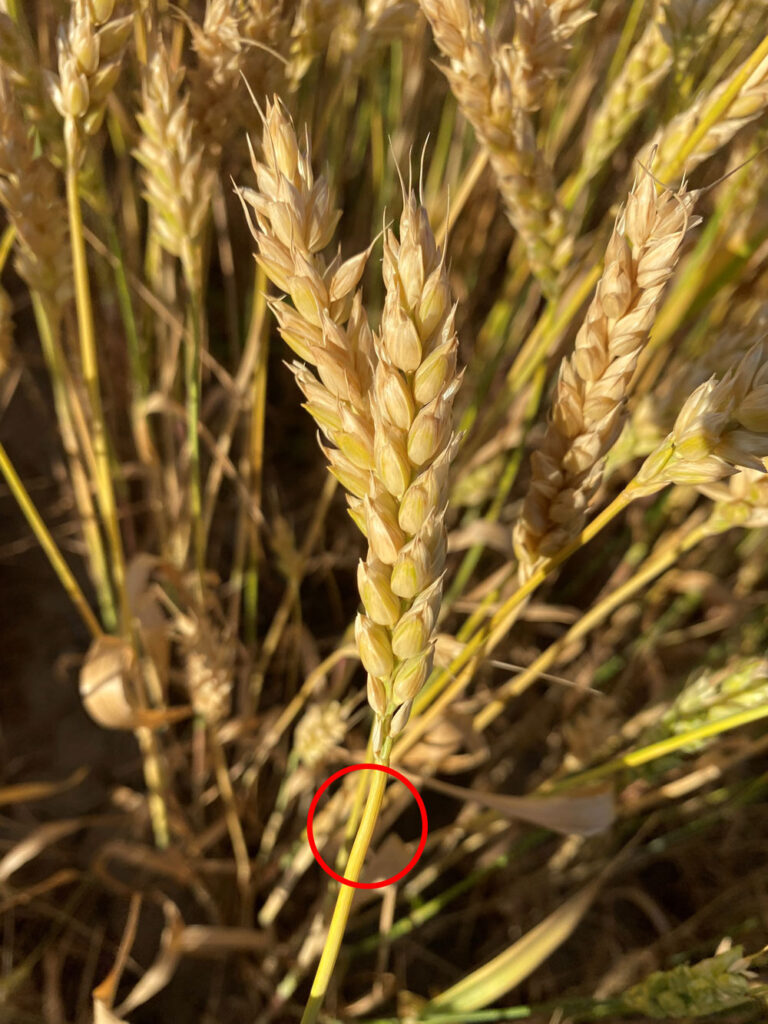
wheat is physiologically mature.
Winter wheat fields are staging anywhere from GS 75 (milk) to GS 92 (ripe). When kernels are in the dough stage, they reach their maximum dry weight and are physiologically mature when the peduncle turns yellow. The kernel moisture drops from roughly 40 per cent to 30 per cent.
Army worm are still marching through fields, be on the lookout and take corrective measures if the option is still viable. Typically, the impact is low later in the season unless they are clipping heads. The key is to assess the damage and how neighbouring crops may be impacted.
Winter wheat harvest will begin soon, as fields in the southwest are turning gold in colour. Warm, dry weather will help ripen the grain. The heavy rains experienced on the weekend did cause some lodged wheat. As harvest approaches, monitor fields closely as the lodged areas are at a greater risk of wetter grain and poor grain quality than the rest of the field.
In preparation for harvest, watch this past GrainTalk webinar on harvest prep and maximizing your combine’s efficiency.
June 29, 2023
‘Knee-high by the first of July’ will be a common sight across the province this year, with some fields even at waist height and advancing quickly. Corn and soybeans are progressing well, especially after very timely rains across much of the province; rain amounts ranged from 0.25 to well over two inches. Winter wheat is inching closer to harvest as it begins to reach physiological maturity.
Corn
Corn across the province is in the V5-V9 stage (7 to 11 leaf stage). The tassel is initiated along with the harvestable corn ear by about the V5 to V6 stage (five to six visible leaf collars, or seven to nine full leaves). Around the V10 stage, if the leaves are removed from the stalk, including the leaf sheaves, there should be some identifiable ear shoots! Now is the time to not cause any plant stress as it will affect ear development.
The number of kernel rows is determined on the main ear shortly after V5 to V6. The number of kernel rows is largely driven by plant genetics (maximum row number) but is influenced by the environment.

Along with the rains received this past weekend, there was some hail that was quite damaging in some areas of the province. Corn, soybeans, and cereal crops were impacted; corn was most impacted as the growing point was destroyed on some acres and lots of tissue shredded on others.
When evaluating corn after hail damage, damaged but viable plants will usually show recovery from the whorl within three to five days if weather and moisture are favourable. One thing that should be done shortly after the storm is to evaluate the relative condition of the main growing point area of the stalk. In this week’s hail, the growing point has been snapped off in some fields; this will lower the stand count, as with a damaged growing point, growth will not continue. Plants that have seen significant leaf damage could see a delay in silking. Overall, though, hail damage that occurs early on in the season almost always looks worse than it is. Five days after the storm will give a better indication of recovery.
Soybeans
Overall, soybean fields are looking good, with some fields close to canopying. This past week’s rain has really given soybeans a boost in growth, and plants can be staged around the V4 (four trifoliates) to R1 (beginning bloom) stages. Flowering begins on the third to sixth node of the plant and continues up and down the stem and then to the branches.
Excessive rains in some areas earlier this week created water ponding. With excessively wet soils, keep an eye out for root diseases, such as Rhizoctonia and fusarium, affecting these waterlogged fields. Tolerant varieties should give a good defence, but standing water will affect these plants. More information on identifying these two rots can be found in this field crop news article.
Fungicide timing is approaching for white mould control. The key to getting the most out of fungicide applications is timing. Risks for white mould include the field history (if there is a known history of white mould, then the chance of it reoccurring is high), variety, row spacing, plant density, and how quickly the field will canopy all factor into the likelihood of infection. Weather patterns will also help determine the risk. When it is foggy/humid, and moisture is on the plant most of the day, there will be a higher risk of white mould. The Sporecaster App can help you determine a field’s risk level. Fungicides can lower the severity of infection; however, timing is critical. Application timing ranges from R1 (single flower on the main stem) to R3 (pod on the main stem). Be sure to speak with an agronomist for optimum timing and product selection, and always follow label recommendations.
Soybean aphids are being found in some areas across the province, currently at low levels. Typically, aphids found earlier in the season will build up populations throughout the year. Although the weather can alter the population, the population of beneficial insects such as ladybugs is more important. If you see aphids, also take note of the beneficial insects. The Aphid Advisor app is a great resource for identifying if action is required.
Cereals
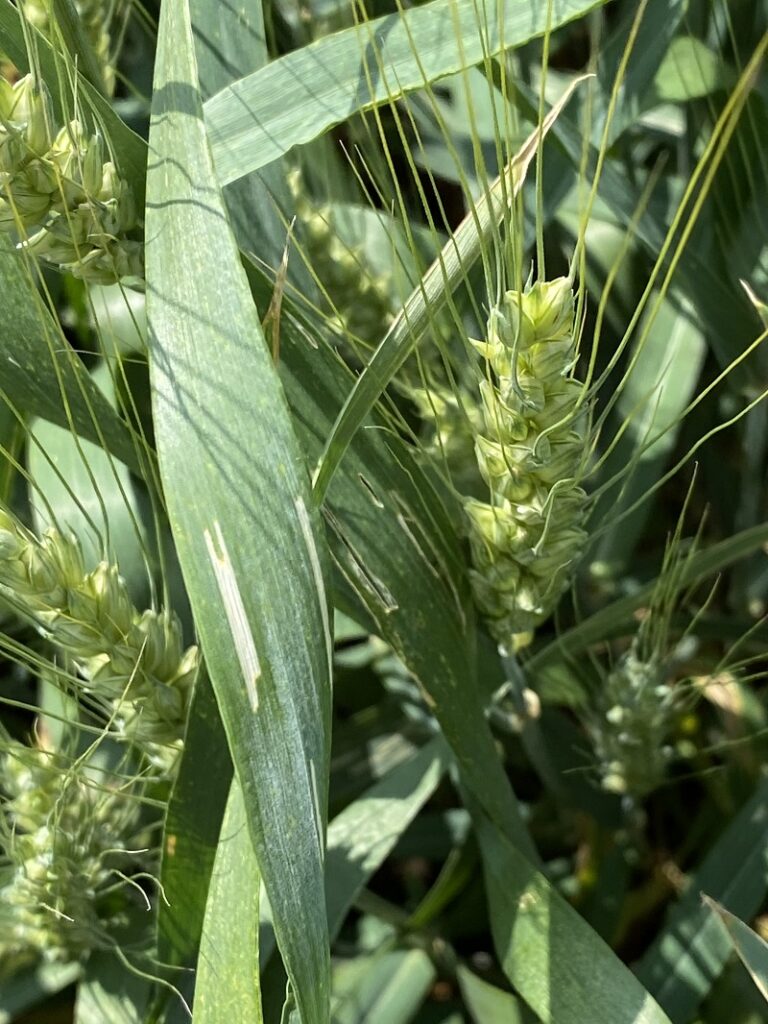
Winter wheat can be staged GS 71 (milk stage) to GS 85. At GS 71, a clear fluid is released when the kernel is squeezed. When the kernel reaches GS 85 the kernel content is a soft-doughy material. The green colour of the kernel, glume and peduncle begins to fade to yellow.
Wheat can be seen to have variable height even within a small area within fields this year, mostly due to the drought conditions earlier in the growing season.
Cereal leaf beetles are being found in fields, some at thresholds. Armyworm has also been spotted, marching in (and eating wheat fields); more info on these pests can be found in this Fieldcrop News article.
Cereal aphids are also being found, which can cause barley yellow dwarf in wheat. You can use the Cereal Aphid Manage App to help decide whether to take action. Be on the lookout for these as out scouting.
Spring cereals are heading out right now.
Winter barley harvest will be starting in the next couple of weeks.
June 22, 2023
Timely rains only reached some of the province; other areas are still waiting for more accumulation which might come later this week. Overall, crops are progressing well for this time of the year.
Corn
Corn across the province is roughly V5 to V8 (seven to 10 leaf tips).
The growing point is out of the ground (at V6), and ear initiation is occurring. Any stress on the crop in the next two weeks will determine rows per ear and kernels per row, as the V12 stage determines this. Make sure the corn crop is well set up to be as stress-free as possible at this time.
With side-dressing wrapping up, it is important to understand how much nitrogen (N) is available for uptake within the soil for the corn crop. Overall, with a cool, dry spring, the N available in soils is most likely lower than average. For more on anticipated available soil N, in this Field Crop News article.
Most second-pass applications of herbicides to catch weeds that got through any pre-emerge herbicides are close to complete. Remember, the critical weed-free period in soybeans is V1 to V3 stage (1st to 3rd trifoliate); in corn, it is V1 to V6 (1 to 6 leaf collars).
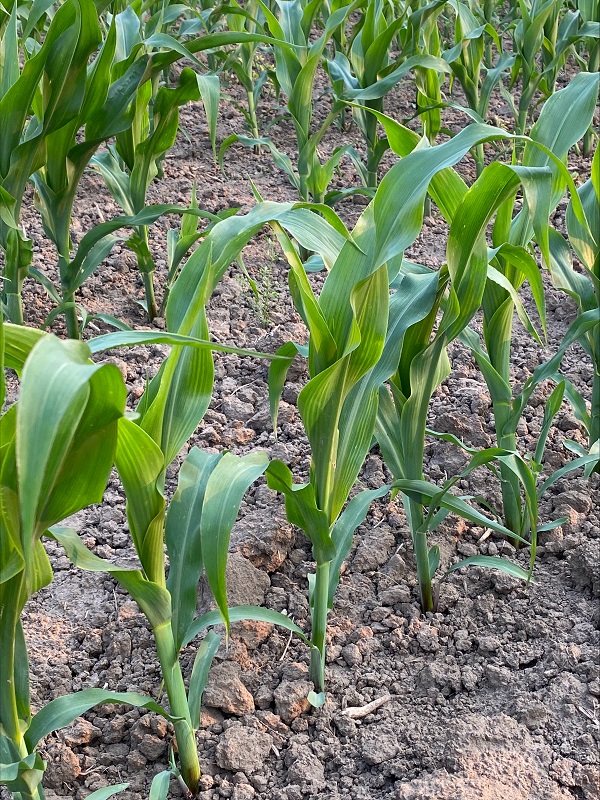
Tracey Baute, OMAFRA field crop entomologist, is looking for corn rootworm trap participants in Ontario. Those with continuous corn and a history of repeated use of Bt-CRW hybrids are encouraged to participate. Fields that were corn last year and maybe in other crops this year can also be scouted for emerging beetle populations. If you are interested in participating in the network and need traps and protocols, please contact Tracey Baute (tracey.baute@ontario.ca) so traps can be sent out before trapping starts at corn pollination timing.
While not as widespread, wildfire smoke is still causing air quality concerns across the province. Smoke can impact crops by lowering temperatures and corn heat units due to reduced solar radiation. Smoke has been dense enough to suppress showers and thunderstorms in all levels of the atmosphere. Overall, there has been a blocking high-pressure system for much of the past few months that can lead to dry conditions, impacting crop development. The longer the fires burn and release smoke, the more potential for growth and development to be affected. And with higher-than-normal temperatures predicted this summer, there may be a stronger chance of more forest fires.
Soybeans
Soybeans are around V2 to V4 (second to fourth trifoliate).
Around this time, soybeans should begin nodulating (five to six weeks after planting). It is always a good idea to see how the nodules are developing. Rhizobia in the soil infects the root and produce nodules on the plant where they fix nitrogen gas from the atmosphere turning it into a more useable form of nitrogen for the plant. In first-time soybean fields, nodules will be found on the tap root; in fields that have had soybeans before, the nodules will be on the lateral roots. They should begin active nitrogen fixation around V2 to V3. The nodules should be quite large (two to four millimetres), and eight to 10 should be found per plant before flowering., If there are fewer, sample again in a week. Nodules that are actively working should be pinkish inside. If the nodules are small and whitish, they have not begun fixing nitrogen yet. As plants switch from soil-available N to fixed N, the plants may become yellowish.
There can be other problems that cause yellow soybeans in fields. Herbicide burn, soybean cyst nematode, dry soil conditions, and manganese (Mn) deficiency (if you see this, apply Mn as soon as possible) can all be possible suspects. Be sure to scout and see if there are patterns on tops of knolly hills, etc., to help determine the cause.
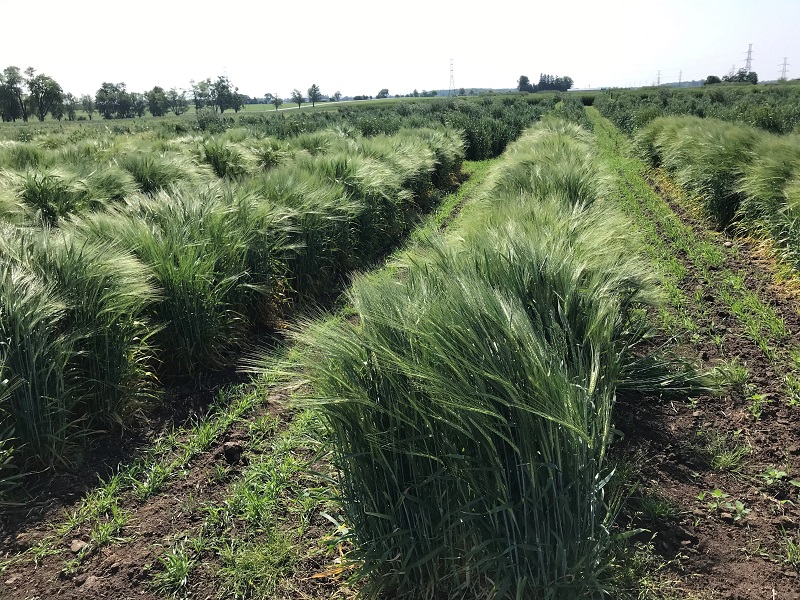
Cereals
This past week treated everyone to cooler day and nighttime temperatures, which is great for wheat in the grain fill period, as the wheat will have more days to fill as fewer growing degree days are accumulated each day. Many regions of Ontario have received rain this past week where they have not in the past, which can help with grain fill as well.
Be on the lookout for true armyworm and cereal leaf beetle; they have reached threshold in some wheat fields. Learn more about what to look for and thresholds in this Field Crop News article.
Winter barley is also in the grain fill stage; it was pollinating through the very hot/dry period so we would anticipate some yield loss.
Looking at the Canadian Drought Monitor, as of May 31, 2023, in the Kitchener/Waterloo/Cambridge region – if a line were drawn from Wyoming to West Lorne and southwest, they were all showing abnormally dry. The region of abnormally dry has surely expanded over the past couple of weeks, as overall, most of the province is below what the 10-year normal would be (except for some northern regions).
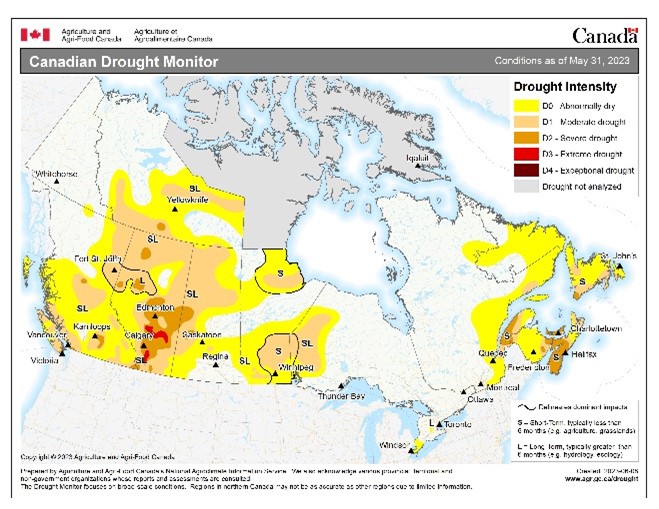
Source: https://agriculture.canada.ca/en/agricultural-production/weather/canadian-drought-monitor/current-drought-conditions
If you are struggling with feeling overwhelmed with decisions, replanting, lack of rain etc. and want to speak with someone, there are many resources available.









